Quick filters:
African slaves Stock Photos and Images
 Taking African slaves on board a slave ship Date: circa 1830 Stock Photohttps://www.alamy.com/image-license-details/?v=1https://www.alamy.com/stock-photo-taking-african-slaves-on-board-a-slave-ship-date-circa-1830-105277406.html
Taking African slaves on board a slave ship Date: circa 1830 Stock Photohttps://www.alamy.com/image-license-details/?v=1https://www.alamy.com/stock-photo-taking-african-slaves-on-board-a-slave-ship-date-circa-1830-105277406.htmlRMG37PBA–Taking African slaves on board a slave ship Date: circa 1830
 CAPTURED AFRICAN SLAVES under watchful eye of the slave master at right Stock Photohttps://www.alamy.com/image-license-details/?v=1https://www.alamy.com/stock-photo-captured-african-slaves-under-watchful-eye-of-the-slave-master-at-27031213.html
CAPTURED AFRICAN SLAVES under watchful eye of the slave master at right Stock Photohttps://www.alamy.com/image-license-details/?v=1https://www.alamy.com/stock-photo-captured-african-slaves-under-watchful-eye-of-the-slave-master-at-27031213.htmlRMBFYAGD–CAPTURED AFRICAN SLAVES under watchful eye of the slave master at right
 Band of African slaves an their way to coast for transportation, passing the remains of slaves from previous bands who have died on the journey Stock Photohttps://www.alamy.com/image-license-details/?v=1https://www.alamy.com/stock-photo-band-of-african-slaves-an-their-way-to-coast-for-transportation-passing-131277783.html
Band of African slaves an their way to coast for transportation, passing the remains of slaves from previous bands who have died on the journey Stock Photohttps://www.alamy.com/image-license-details/?v=1https://www.alamy.com/stock-photo-band-of-african-slaves-an-their-way-to-coast-for-transportation-passing-131277783.htmlRMHHG647–Band of African slaves an their way to coast for transportation, passing the remains of slaves from previous bands who have died on the journey
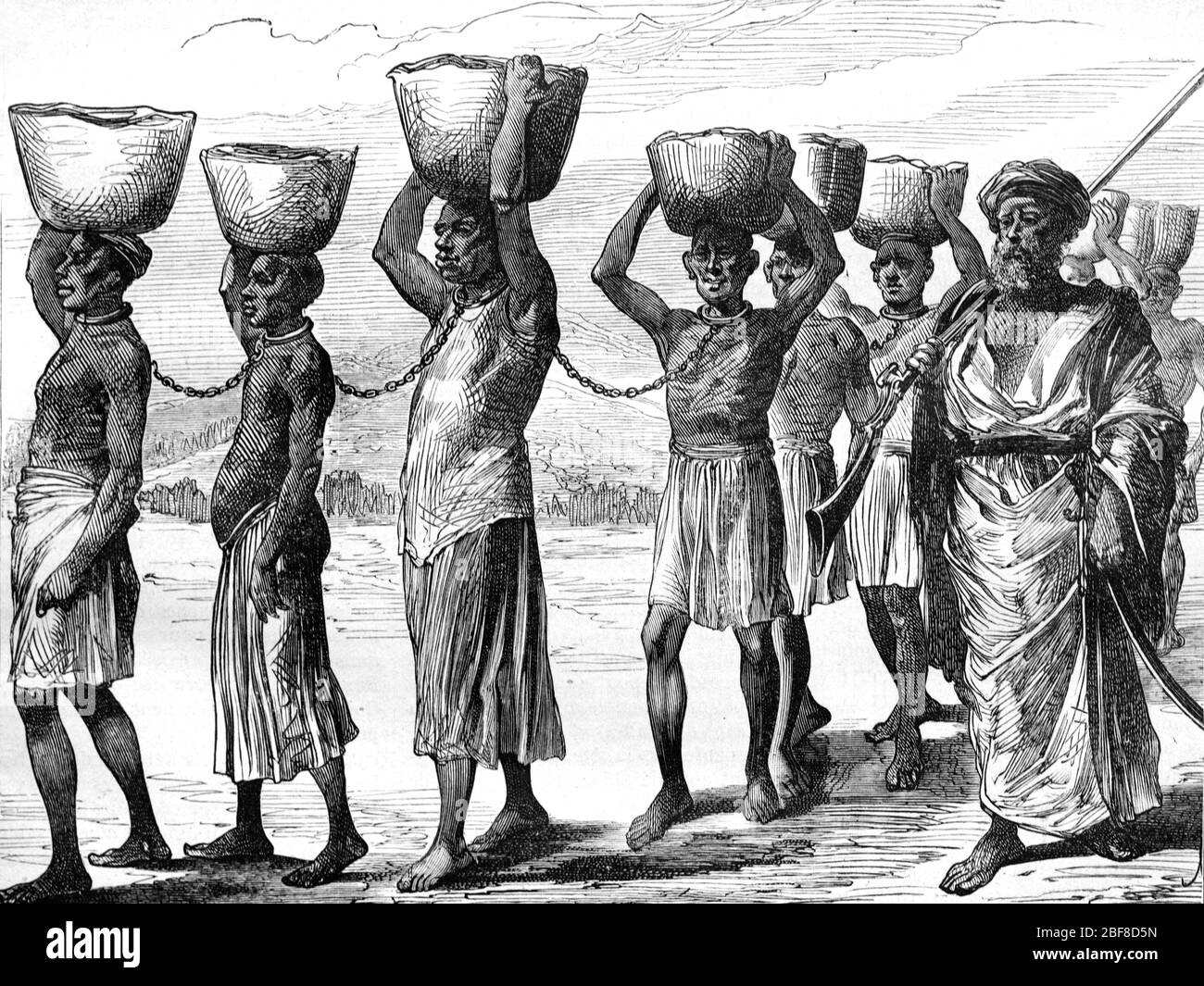 Arab Slave Trader Leading Chained African Slaves in Zanzibar Tanzania Africa. Vintage or Old Illustration or Engraving 1889 Stock Photohttps://www.alamy.com/image-license-details/?v=1https://www.alamy.com/arab-slave-trader-leading-chained-african-slaves-in-zanzibar-tanzania-africa-vintage-or-old-illustration-or-engraving-1889-image353613169.html
Arab Slave Trader Leading Chained African Slaves in Zanzibar Tanzania Africa. Vintage or Old Illustration or Engraving 1889 Stock Photohttps://www.alamy.com/image-license-details/?v=1https://www.alamy.com/arab-slave-trader-leading-chained-african-slaves-in-zanzibar-tanzania-africa-vintage-or-old-illustration-or-engraving-1889-image353613169.htmlRM2BF8D5N–Arab Slave Trader Leading Chained African Slaves in Zanzibar Tanzania Africa. Vintage or Old Illustration or Engraving 1889
 African Slaves' Feast in Surinam Stock Photohttps://www.alamy.com/image-license-details/?v=1https://www.alamy.com/african-slaves-feast-in-surinam-image179865851.html
African Slaves' Feast in Surinam Stock Photohttps://www.alamy.com/image-license-details/?v=1https://www.alamy.com/african-slaves-feast-in-surinam-image179865851.htmlRMMCHGMB–African Slaves' Feast in Surinam
 Slaves exposed for sale - Slave market Stock Photohttps://www.alamy.com/image-license-details/?v=1https://www.alamy.com/stock-photo-slaves-exposed-for-sale-slave-market-30209916.html
Slaves exposed for sale - Slave market Stock Photohttps://www.alamy.com/image-license-details/?v=1https://www.alamy.com/stock-photo-slaves-exposed-for-sale-slave-market-30209916.htmlRMBN451G–Slaves exposed for sale - Slave market
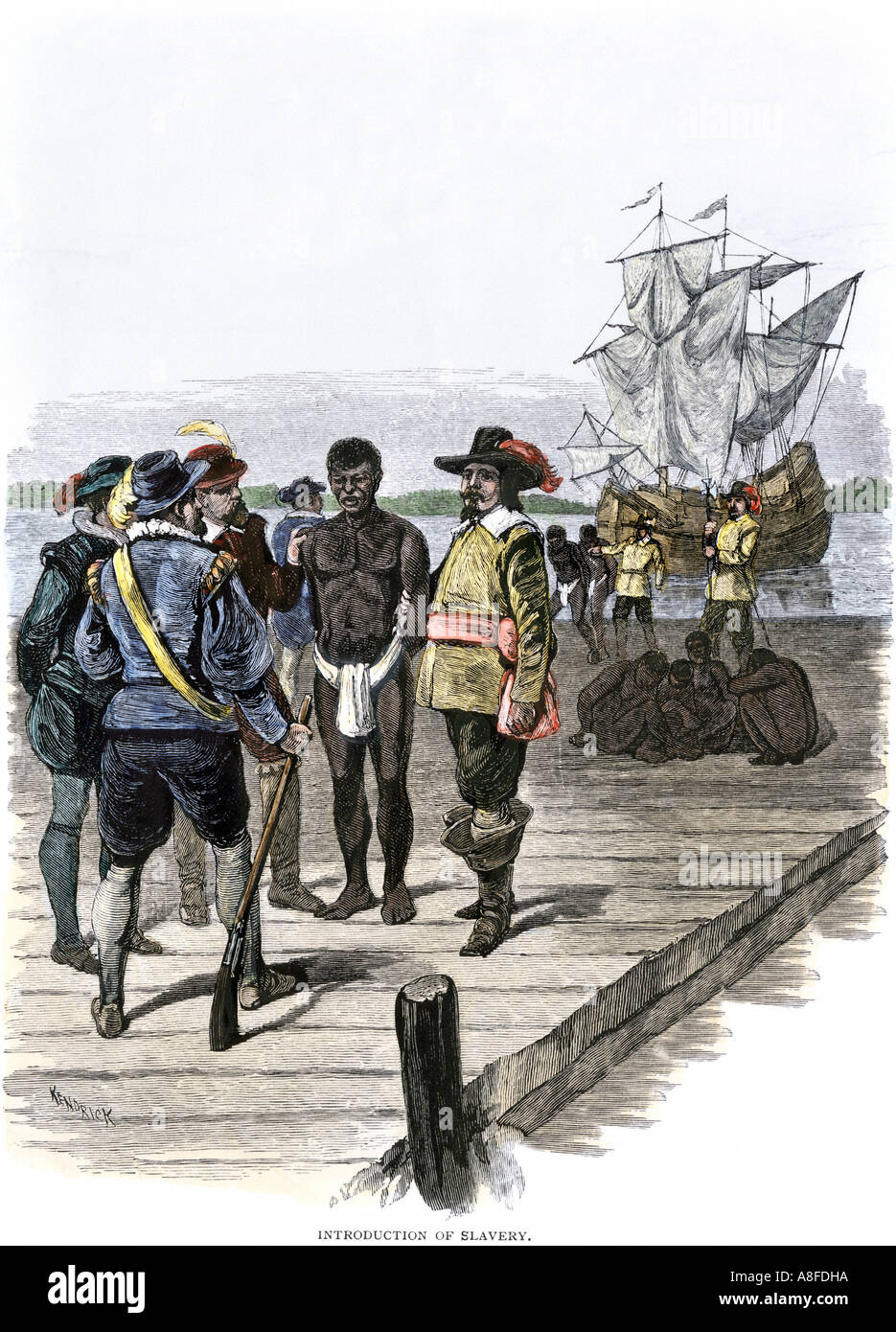 African slaves introduced into Virginia Colony at Jamestown 1600s. Hand-colored woodcut Stock Photohttps://www.alamy.com/image-license-details/?v=1https://www.alamy.com/african-slaves-introduced-into-virginia-colony-at-jamestown-1600s-image6907097.html
African slaves introduced into Virginia Colony at Jamestown 1600s. Hand-colored woodcut Stock Photohttps://www.alamy.com/image-license-details/?v=1https://www.alamy.com/african-slaves-introduced-into-virginia-colony-at-jamestown-1600s-image6907097.htmlRMA8FDHA–African slaves introduced into Virginia Colony at Jamestown 1600s. Hand-colored woodcut
 19th century Woodcut print on paper of a cut section a ship transporting African slaves from L'art Naval by Leon Renard, Published in 1881 Stock Photohttps://www.alamy.com/image-license-details/?v=1https://www.alamy.com/19th-century-woodcut-print-on-paper-of-a-cut-section-a-ship-transporting-african-slaves-from-lart-naval-by-leon-renard-published-in-1881-image342540233.html
19th century Woodcut print on paper of a cut section a ship transporting African slaves from L'art Naval by Leon Renard, Published in 1881 Stock Photohttps://www.alamy.com/image-license-details/?v=1https://www.alamy.com/19th-century-woodcut-print-on-paper-of-a-cut-section-a-ship-transporting-african-slaves-from-lart-naval-by-leon-renard-published-in-1881-image342540233.htmlRM2AW81FN–19th century Woodcut print on paper of a cut section a ship transporting African slaves from L'art Naval by Leon Renard, Published in 1881
 Entitled: 'Stowage of the British slave ship Brookes under the regulated slave trade act of 1788.' Slave ships were large cargo ships specially converted for the purpose of transporting slaves, especially newly purchased African slaves to the Americas. In Stock Photohttps://www.alamy.com/image-license-details/?v=1https://www.alamy.com/stock-photo-entitled-stowage-of-the-british-slave-ship-brookes-under-the-regulated-104019628.html
Entitled: 'Stowage of the British slave ship Brookes under the regulated slave trade act of 1788.' Slave ships were large cargo ships specially converted for the purpose of transporting slaves, especially newly purchased African slaves to the Americas. In Stock Photohttps://www.alamy.com/image-license-details/?v=1https://www.alamy.com/stock-photo-entitled-stowage-of-the-british-slave-ship-brookes-under-the-regulated-104019628.htmlRMG16E2M–Entitled: 'Stowage of the British slave ship Brookes under the regulated slave trade act of 1788.' Slave ships were large cargo ships specially converted for the purpose of transporting slaves, especially newly purchased African slaves to the Americas. In
 African slaves skinning a huge snake under a tree, and Graman Quacy or Quassi, the Surinam slave who discovered quassia. Handcoloured copperplate engraving by Migliavacca from Giulio Ferrrario's Costumes Antique and Modern of All Peoples (Il Costume Antico e Moderno di Tutti i Popoli), Florence, 1842. Stock Photohttps://www.alamy.com/image-license-details/?v=1https://www.alamy.com/african-slaves-skinning-a-huge-snake-under-a-tree-and-graman-quacy-or-quassi-the-surinam-slave-who-discovered-quassia-handcoloured-copperplate-engraving-by-migliavacca-from-giulio-ferrrarios-costumes-antique-and-modern-of-all-peoples-il-costume-antico-e-moderno-di-tutti-i-popoli-florence-1842-image331884026.html
African slaves skinning a huge snake under a tree, and Graman Quacy or Quassi, the Surinam slave who discovered quassia. Handcoloured copperplate engraving by Migliavacca from Giulio Ferrrario's Costumes Antique and Modern of All Peoples (Il Costume Antico e Moderno di Tutti i Popoli), Florence, 1842. Stock Photohttps://www.alamy.com/image-license-details/?v=1https://www.alamy.com/african-slaves-skinning-a-huge-snake-under-a-tree-and-graman-quacy-or-quassi-the-surinam-slave-who-discovered-quassia-handcoloured-copperplate-engraving-by-migliavacca-from-giulio-ferrrarios-costumes-antique-and-modern-of-all-peoples-il-costume-antico-e-moderno-di-tutti-i-popoli-florence-1842-image331884026.htmlRM2A7XHCX–African slaves skinning a huge snake under a tree, and Graman Quacy or Quassi, the Surinam slave who discovered quassia. Handcoloured copperplate engraving by Migliavacca from Giulio Ferrrario's Costumes Antique and Modern of All Peoples (Il Costume Antico e Moderno di Tutti i Popoli), Florence, 1842.
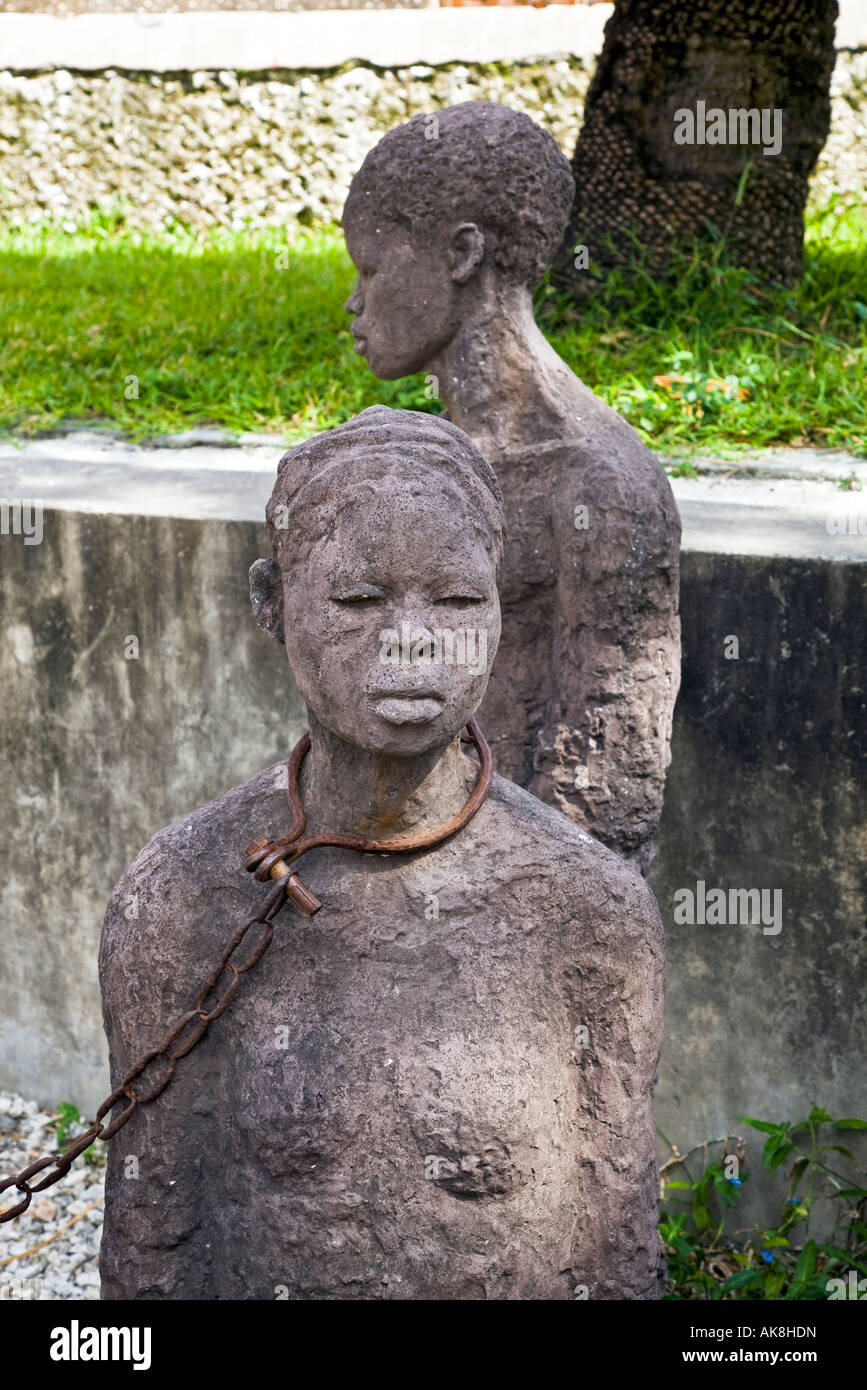 Sculpture of slaves chained in a pit at the former slave market beside the Anglican Cathedral Church of Christ Mkunazini 2007 Stock Photohttps://www.alamy.com/image-license-details/?v=1https://www.alamy.com/stock-photo-sculpture-of-slaves-chained-in-a-pit-at-the-former-slave-market-beside-14920688.html
Sculpture of slaves chained in a pit at the former slave market beside the Anglican Cathedral Church of Christ Mkunazini 2007 Stock Photohttps://www.alamy.com/image-license-details/?v=1https://www.alamy.com/stock-photo-sculpture-of-slaves-chained-in-a-pit-at-the-former-slave-market-beside-14920688.htmlRMAK8HDN–Sculpture of slaves chained in a pit at the former slave market beside the Anglican Cathedral Church of Christ Mkunazini 2007
 sculpture of a couple of slaves in Goree island dakar senegal Stock Photohttps://www.alamy.com/image-license-details/?v=1https://www.alamy.com/stock-photo-sculpture-of-a-couple-of-slaves-in-goree-island-dakar-senegal-22684034.html
sculpture of a couple of slaves in Goree island dakar senegal Stock Photohttps://www.alamy.com/image-license-details/?v=1https://www.alamy.com/stock-photo-sculpture-of-a-couple-of-slaves-in-goree-island-dakar-senegal-22684034.htmlRFB8W9M2–sculpture of a couple of slaves in Goree island dakar senegal
 A Group of Arab Slave Dealers (From a photograph taken in Zanzibar) a photograph from the book ' The history of the Universities' Mission to Central Africa, 1859-1898 ' by Anne Elizabeth Mary Anderson Morshead, Universities' Mission to Central Africa 1899 Stock Photohttps://www.alamy.com/image-license-details/?v=1https://www.alamy.com/a-group-of-arab-slave-dealers-from-a-photograph-taken-in-zanzibar-a-photograph-from-the-book-the-history-of-the-universities-mission-to-central-africa-1859-1898-by-anne-elizabeth-mary-anderson-morshead-universities-mission-to-central-africa-1899-image456333820.html
A Group of Arab Slave Dealers (From a photograph taken in Zanzibar) a photograph from the book ' The history of the Universities' Mission to Central Africa, 1859-1898 ' by Anne Elizabeth Mary Anderson Morshead, Universities' Mission to Central Africa 1899 Stock Photohttps://www.alamy.com/image-license-details/?v=1https://www.alamy.com/a-group-of-arab-slave-dealers-from-a-photograph-taken-in-zanzibar-a-photograph-from-the-book-the-history-of-the-universities-mission-to-central-africa-1859-1898-by-anne-elizabeth-mary-anderson-morshead-universities-mission-to-central-africa-1899-image456333820.htmlRF2HEBPCC–A Group of Arab Slave Dealers (From a photograph taken in Zanzibar) a photograph from the book ' The history of the Universities' Mission to Central Africa, 1859-1898 ' by Anne Elizabeth Mary Anderson Morshead, Universities' Mission to Central Africa 1899
 Old slave list from the national archives Seychelles Stock Photohttps://www.alamy.com/image-license-details/?v=1https://www.alamy.com/stock-photo-old-slave-list-from-the-national-archives-seychelles-72908055.html
Old slave list from the national archives Seychelles Stock Photohttps://www.alamy.com/image-license-details/?v=1https://www.alamy.com/stock-photo-old-slave-list-from-the-national-archives-seychelles-72908055.htmlRME6H6Y3–Old slave list from the national archives Seychelles
 Slave ship diagram showing how African slaves were arranged and transported aboard the ship during the slave trade years, 1823 Stock Photohttps://www.alamy.com/image-license-details/?v=1https://www.alamy.com/slave-ship-diagram-showing-how-african-slaves-were-arranged-and-transported-aboard-the-ship-during-the-slave-trade-years-1823-image245172340.html
Slave ship diagram showing how African slaves were arranged and transported aboard the ship during the slave trade years, 1823 Stock Photohttps://www.alamy.com/image-license-details/?v=1https://www.alamy.com/slave-ship-diagram-showing-how-african-slaves-were-arranged-and-transported-aboard-the-ship-during-the-slave-trade-years-1823-image245172340.htmlRMT6TFR0–Slave ship diagram showing how African slaves were arranged and transported aboard the ship during the slave trade years, 1823
 African slaves abandoned by slave traders in the 19th century. Stock Photohttps://www.alamy.com/image-license-details/?v=1https://www.alamy.com/stock-photo-african-slaves-abandoned-by-slave-traders-in-the-19th-century-31249528.html
African slaves abandoned by slave traders in the 19th century. Stock Photohttps://www.alamy.com/image-license-details/?v=1https://www.alamy.com/stock-photo-african-slaves-abandoned-by-slave-traders-in-the-19th-century-31249528.htmlRMBPRF2G–African slaves abandoned by slave traders in the 19th century.
 'The African slave-trade - slaves taken from a dhow captured by H.M.S. Undine'. Illustration of the slave trade published in The Graphic, London, June 7, 1884. Stock Photohttps://www.alamy.com/image-license-details/?v=1https://www.alamy.com/stock-photo-the-african-slave-trade-slaves-taken-from-a-dhow-captured-by-hms-undine-109734245.html
'The African slave-trade - slaves taken from a dhow captured by H.M.S. Undine'. Illustration of the slave trade published in The Graphic, London, June 7, 1884. Stock Photohttps://www.alamy.com/image-license-details/?v=1https://www.alamy.com/stock-photo-the-african-slave-trade-slaves-taken-from-a-dhow-captured-by-hms-undine-109734245.htmlRMGAER45–'The African slave-trade - slaves taken from a dhow captured by H.M.S. Undine'. Illustration of the slave trade published in The Graphic, London, June 7, 1884.
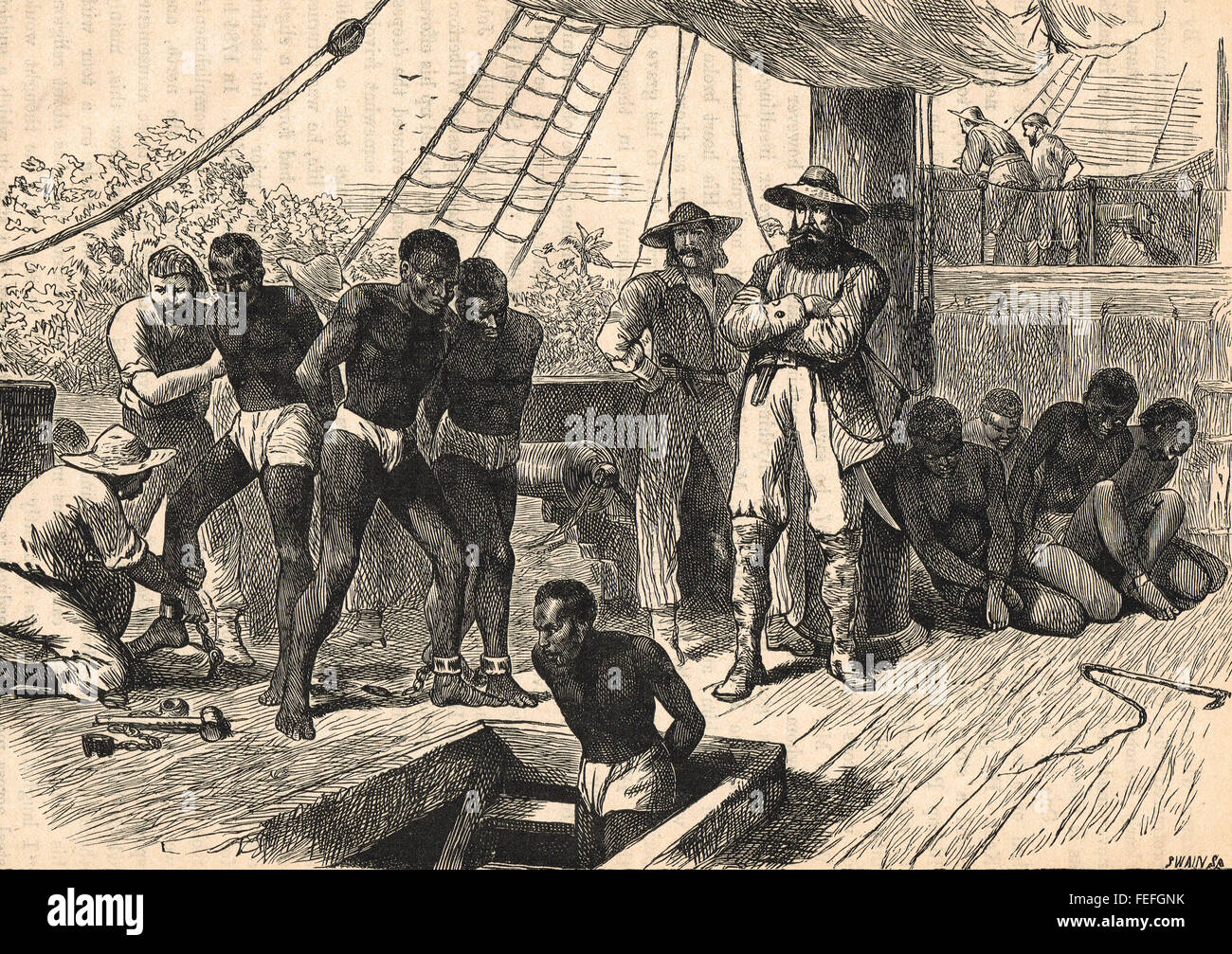 Fitting shackles on board a slave ship Stock Photohttps://www.alamy.com/image-license-details/?v=1https://www.alamy.com/stock-photo-fitting-shackles-on-board-a-slave-ship-94999455.html
Fitting shackles on board a slave ship Stock Photohttps://www.alamy.com/image-license-details/?v=1https://www.alamy.com/stock-photo-fitting-shackles-on-board-a-slave-ship-94999455.htmlRMFEFGNK–Fitting shackles on board a slave ship
 Lantern Slide - The Slave Gang, Life & Work of Dr David Livingstone, circa 1900, Lantern Slide depicting a group of African slaves with a man on horse back with a raised whip in background. It is part of an incomplete set of 40 slides, two are missing, illustrating highlights from Livingstone's life and travels. These slides were manufactured by the London Stereoscopic & Photographic Company for The London Missionary Society, circa 1900. Dr. David Livingstone (1813-1873 Stock Photohttps://www.alamy.com/image-license-details/?v=1https://www.alamy.com/lantern-slide-the-slave-gang-life-work-of-dr-david-livingstone-circa-1900-lantern-slide-depicting-a-group-of-african-slaves-with-a-man-on-horse-back-with-a-raised-whip-in-background-it-is-part-of-an-incomplete-set-of-40-slides-two-are-missing-illustrating-highlights-from-livingstones-life-and-travels-these-slides-were-manufactured-by-the-london-stereoscopic-photographic-company-for-the-london-missionary-society-circa-1900-dr-david-livingstone-1813-1873-image328790062.html
Lantern Slide - The Slave Gang, Life & Work of Dr David Livingstone, circa 1900, Lantern Slide depicting a group of African slaves with a man on horse back with a raised whip in background. It is part of an incomplete set of 40 slides, two are missing, illustrating highlights from Livingstone's life and travels. These slides were manufactured by the London Stereoscopic & Photographic Company for The London Missionary Society, circa 1900. Dr. David Livingstone (1813-1873 Stock Photohttps://www.alamy.com/image-license-details/?v=1https://www.alamy.com/lantern-slide-the-slave-gang-life-work-of-dr-david-livingstone-circa-1900-lantern-slide-depicting-a-group-of-african-slaves-with-a-man-on-horse-back-with-a-raised-whip-in-background-it-is-part-of-an-incomplete-set-of-40-slides-two-are-missing-illustrating-highlights-from-livingstones-life-and-travels-these-slides-were-manufactured-by-the-london-stereoscopic-photographic-company-for-the-london-missionary-society-circa-1900-dr-david-livingstone-1813-1873-image328790062.htmlRM2A2WK26–Lantern Slide - The Slave Gang, Life & Work of Dr David Livingstone, circa 1900, Lantern Slide depicting a group of African slaves with a man on horse back with a raised whip in background. It is part of an incomplete set of 40 slides, two are missing, illustrating highlights from Livingstone's life and travels. These slides were manufactured by the London Stereoscopic & Photographic Company for The London Missionary Society, circa 1900. Dr. David Livingstone (1813-1873
 A 'barracoon' in Sierra Leone, West Africa, where slaves are held prior to shipment, for months on end, chained by neck and legs, and frequently flogged Date: 1849 Stock Photohttps://www.alamy.com/image-license-details/?v=1https://www.alamy.com/a-barracoon-in-sierra-leone-west-africa-where-slaves-are-held-prior-to-shipment-for-months-on-end-chained-by-neck-and-legs-and-frequently-flogged-date-1849-image183006412.html
A 'barracoon' in Sierra Leone, West Africa, where slaves are held prior to shipment, for months on end, chained by neck and legs, and frequently flogged Date: 1849 Stock Photohttps://www.alamy.com/image-license-details/?v=1https://www.alamy.com/a-barracoon-in-sierra-leone-west-africa-where-slaves-are-held-prior-to-shipment-for-months-on-end-chained-by-neck-and-legs-and-frequently-flogged-date-1849-image183006412.htmlRMMHMJF8–A 'barracoon' in Sierra Leone, West Africa, where slaves are held prior to shipment, for months on end, chained by neck and legs, and frequently flogged Date: 1849
 ZONG MASSACRE - contemporary woodcut of the mass-killing of African slaves in 1781 thrown overboard from the ZONG trading ship Stock Photohttps://www.alamy.com/image-license-details/?v=1https://www.alamy.com/stock-photo-zong-massacre-contemporary-woodcut-of-the-mass-killing-of-african-29648081.html
ZONG MASSACRE - contemporary woodcut of the mass-killing of African slaves in 1781 thrown overboard from the ZONG trading ship Stock Photohttps://www.alamy.com/image-license-details/?v=1https://www.alamy.com/stock-photo-zong-massacre-contemporary-woodcut-of-the-mass-killing-of-african-29648081.htmlRMBM6GC1–ZONG MASSACRE - contemporary woodcut of the mass-killing of African slaves in 1781 thrown overboard from the ZONG trading ship
 French Revolutionary illustration calling for freedom for African slaves 1791 Stock Photohttps://www.alamy.com/image-license-details/?v=1https://www.alamy.com/french-revolutionary-illustration-calling-for-freedom-for-african-slaves-1791-image328345082.html
French Revolutionary illustration calling for freedom for African slaves 1791 Stock Photohttps://www.alamy.com/image-license-details/?v=1https://www.alamy.com/french-revolutionary-illustration-calling-for-freedom-for-african-slaves-1791-image328345082.htmlRM2A25BE2–French Revolutionary illustration calling for freedom for African slaves 1791
 Black African Slaves Thrown off Slave Ship into Sea. Slave Trade and People Traffickers (Engraving, 1888) Stock Photohttps://www.alamy.com/image-license-details/?v=1https://www.alamy.com/stock-photo-black-african-slaves-thrown-off-slave-ship-into-sea-slave-trade-and-175146188.html
Black African Slaves Thrown off Slave Ship into Sea. Slave Trade and People Traffickers (Engraving, 1888) Stock Photohttps://www.alamy.com/image-license-details/?v=1https://www.alamy.com/stock-photo-black-african-slaves-thrown-off-slave-ship-into-sea-slave-trade-and-175146188.htmlRMM4XGN0–Black African Slaves Thrown off Slave Ship into Sea. Slave Trade and People Traffickers (Engraving, 1888)
 Colonial America (1607-1762). African slaves jumping the ship in orden to obtain freedom. Engraving colored. Stock Photohttps://www.alamy.com/image-license-details/?v=1https://www.alamy.com/colonial-america-1607-1762-african-slaves-jumping-the-ship-in-orden-image69373722.html
Colonial America (1607-1762). African slaves jumping the ship in orden to obtain freedom. Engraving colored. Stock Photohttps://www.alamy.com/image-license-details/?v=1https://www.alamy.com/colonial-america-1607-1762-african-slaves-jumping-the-ship-in-orden-image69373722.htmlRME0T6TX–Colonial America (1607-1762). African slaves jumping the ship in orden to obtain freedom. Engraving colored.
 Sacrifice of slaves observed during the Stanley Expedition Stock Photohttps://www.alamy.com/image-license-details/?v=1https://www.alamy.com/stock-photo-sacrifice-of-slaves-observed-during-the-stanley-expedition-124520267.html
Sacrifice of slaves observed during the Stanley Expedition Stock Photohttps://www.alamy.com/image-license-details/?v=1https://www.alamy.com/stock-photo-sacrifice-of-slaves-observed-during-the-stanley-expedition-124520267.htmlRMH6GATB–Sacrifice of slaves observed during the Stanley Expedition
 West African native canoe full of captives to be sold as slaves. Hand-colored woodcut of an E. W. Kemble illustration Stock Photohttps://www.alamy.com/image-license-details/?v=1https://www.alamy.com/west-african-native-canoe-full-of-captives-to-be-sold-as-slaves-hand-image8052279.html
West African native canoe full of captives to be sold as slaves. Hand-colored woodcut of an E. W. Kemble illustration Stock Photohttps://www.alamy.com/image-license-details/?v=1https://www.alamy.com/west-african-native-canoe-full-of-captives-to-be-sold-as-slaves-hand-image8052279.htmlRMAG4DR8–West African native canoe full of captives to be sold as slaves. Hand-colored woodcut of an E. W. Kemble illustration
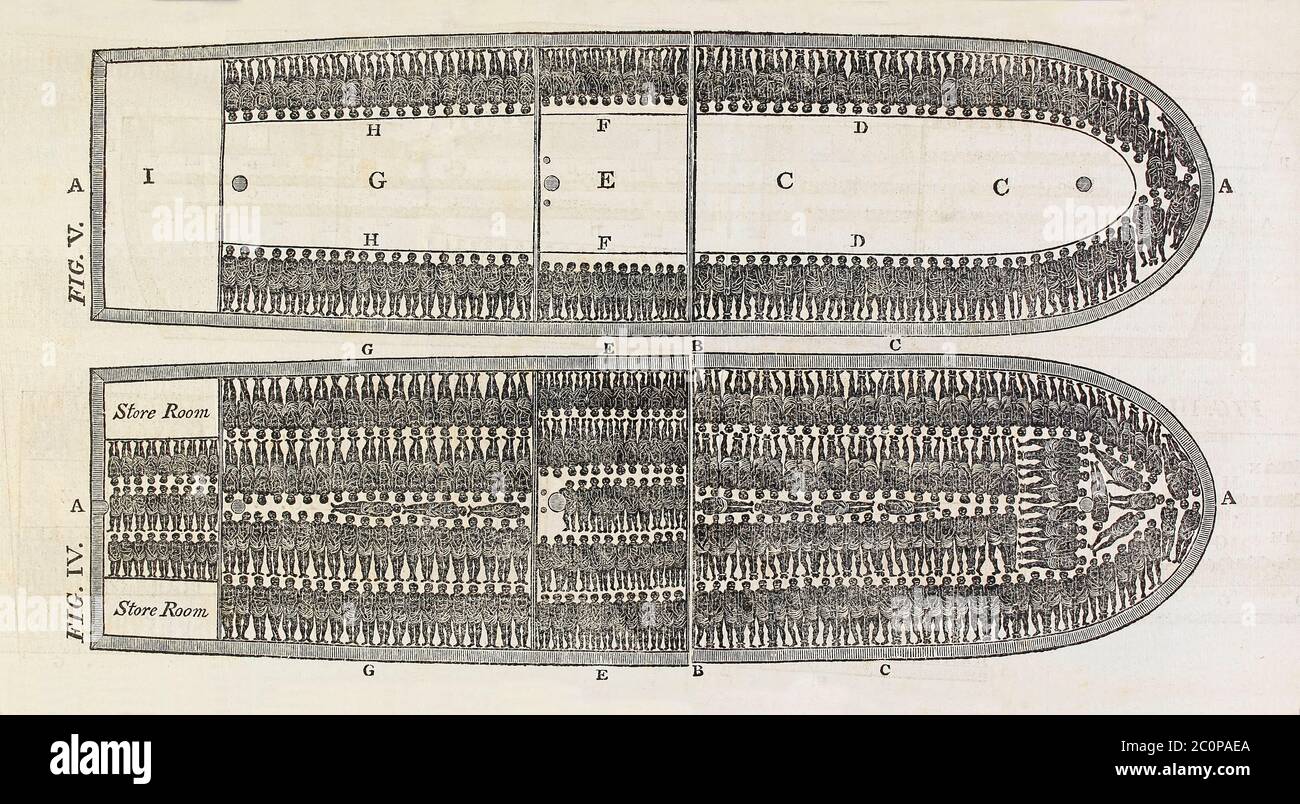 Plan of the slave ship Brookes designed to show the suffering of African slaves transported in the Middle Passage during the transatlantic slave trade. This famous illustration first published in 1787 was widely disseminated and did much to advance the abolitionist cause by showing the inhumanity of the slave trade. Stock Photohttps://www.alamy.com/image-license-details/?v=1https://www.alamy.com/plan-of-the-slave-ship-brookes-designed-to-show-the-suffering-of-african-slaves-transported-in-the-middle-passage-during-the-transatlantic-slave-trade-this-famous-illustration-first-published-in-1787-was-widely-disseminated-and-did-much-to-advance-the-abolitionist-cause-by-showing-the-inhumanity-of-the-slave-trade-image361908914.html
Plan of the slave ship Brookes designed to show the suffering of African slaves transported in the Middle Passage during the transatlantic slave trade. This famous illustration first published in 1787 was widely disseminated and did much to advance the abolitionist cause by showing the inhumanity of the slave trade. Stock Photohttps://www.alamy.com/image-license-details/?v=1https://www.alamy.com/plan-of-the-slave-ship-brookes-designed-to-show-the-suffering-of-african-slaves-transported-in-the-middle-passage-during-the-transatlantic-slave-trade-this-famous-illustration-first-published-in-1787-was-widely-disseminated-and-did-much-to-advance-the-abolitionist-cause-by-showing-the-inhumanity-of-the-slave-trade-image361908914.htmlRM2C0PAEA–Plan of the slave ship Brookes designed to show the suffering of African slaves transported in the Middle Passage during the transatlantic slave trade. This famous illustration first published in 1787 was widely disseminated and did much to advance the abolitionist cause by showing the inhumanity of the slave trade.
 Slaves exposed for sale. The Atlantic slave trade involved the transportation by slave traders of enslaved African people, mainly to the Americas. The vast majority of those who were enslaved and transported in the transatlantic slave trade were Africans from central and western Africa, who had been sold by other West Africans to Western European slave traders, who brought them to the Americas. The South Atlantic and Caribbean economies especially were dependent on the supply of secure labour for the production of commodity crops, making goods and clothing to sell in Europe. No artist credited Stock Photohttps://www.alamy.com/image-license-details/?v=1https://www.alamy.com/slaves-exposed-for-sale-the-atlantic-slave-trade-involved-the-transportation-by-slave-traders-of-enslaved-african-people-mainly-to-the-americas-the-vast-majority-of-those-who-were-enslaved-and-transported-in-the-transatlantic-slave-trade-were-africans-from-central-and-western-africa-who-had-been-sold-by-other-west-africans-to-western-european-slave-traders-who-brought-them-to-the-americas-the-south-atlantic-and-caribbean-economies-especially-were-dependent-on-the-supply-of-secure-labour-for-the-production-of-commodity-crops-making-goods-and-clothing-to-sell-in-europe-no-artist-credited-image458812862.html
Slaves exposed for sale. The Atlantic slave trade involved the transportation by slave traders of enslaved African people, mainly to the Americas. The vast majority of those who were enslaved and transported in the transatlantic slave trade were Africans from central and western Africa, who had been sold by other West Africans to Western European slave traders, who brought them to the Americas. The South Atlantic and Caribbean economies especially were dependent on the supply of secure labour for the production of commodity crops, making goods and clothing to sell in Europe. No artist credited Stock Photohttps://www.alamy.com/image-license-details/?v=1https://www.alamy.com/slaves-exposed-for-sale-the-atlantic-slave-trade-involved-the-transportation-by-slave-traders-of-enslaved-african-people-mainly-to-the-americas-the-vast-majority-of-those-who-were-enslaved-and-transported-in-the-transatlantic-slave-trade-were-africans-from-central-and-western-africa-who-had-been-sold-by-other-west-africans-to-western-european-slave-traders-who-brought-them-to-the-americas-the-south-atlantic-and-caribbean-economies-especially-were-dependent-on-the-supply-of-secure-labour-for-the-production-of-commodity-crops-making-goods-and-clothing-to-sell-in-europe-no-artist-credited-image458812862.htmlRM2HJCMDJ–Slaves exposed for sale. The Atlantic slave trade involved the transportation by slave traders of enslaved African people, mainly to the Americas. The vast majority of those who were enslaved and transported in the transatlantic slave trade were Africans from central and western Africa, who had been sold by other West Africans to Western European slave traders, who brought them to the Americas. The South Atlantic and Caribbean economies especially were dependent on the supply of secure labour for the production of commodity crops, making goods and clothing to sell in Europe. No artist credited
 SLAVERY - An illustration for serialised magazine story 'The Governor of the Colony' by Captain K Maclure 1932 showing an island governor in tricorn hat, African slaves in transit and before capture Stock Photohttps://www.alamy.com/image-license-details/?v=1https://www.alamy.com/stock-image-slavery-an-illustration-for-serialised-magazine-story-the-governor-169879481.html
SLAVERY - An illustration for serialised magazine story 'The Governor of the Colony' by Captain K Maclure 1932 showing an island governor in tricorn hat, African slaves in transit and before capture Stock Photohttps://www.alamy.com/image-license-details/?v=1https://www.alamy.com/stock-image-slavery-an-illustration-for-serialised-magazine-story-the-governor-169879481.htmlRMKTAK09–SLAVERY - An illustration for serialised magazine story 'The Governor of the Colony' by Captain K Maclure 1932 showing an island governor in tricorn hat, African slaves in transit and before capture
 Sculpture of slaves chained in a pit at the former slave market beside the Anglican Cathedral Church of Christ Mkunazini 2007 Stock Photohttps://www.alamy.com/image-license-details/?v=1https://www.alamy.com/stock-photo-sculpture-of-slaves-chained-in-a-pit-at-the-former-slave-market-beside-14913589.html
Sculpture of slaves chained in a pit at the former slave market beside the Anglican Cathedral Church of Christ Mkunazini 2007 Stock Photohttps://www.alamy.com/image-license-details/?v=1https://www.alamy.com/stock-photo-sculpture-of-slaves-chained-in-a-pit-at-the-former-slave-market-beside-14913589.htmlRMAK7T9X–Sculpture of slaves chained in a pit at the former slave market beside the Anglican Cathedral Church of Christ Mkunazini 2007
 A display of Gullah basket weaving in Charleston SC. The Gullah are descendents of African slaves. They have a distinct landguage and culture. Stock Photohttps://www.alamy.com/image-license-details/?v=1https://www.alamy.com/a-display-of-gullah-basket-weaving-in-charleston-sc-the-gullah-are-descendents-of-african-slaves-they-have-a-distinct-landguage-and-culture-image246697508.html
A display of Gullah basket weaving in Charleston SC. The Gullah are descendents of African slaves. They have a distinct landguage and culture. Stock Photohttps://www.alamy.com/image-license-details/?v=1https://www.alamy.com/a-display-of-gullah-basket-weaving-in-charleston-sc-the-gullah-are-descendents-of-african-slaves-they-have-a-distinct-landguage-and-culture-image246697508.htmlRMT9A158–A display of Gullah basket weaving in Charleston SC. The Gullah are descendents of African slaves. They have a distinct landguage and culture.
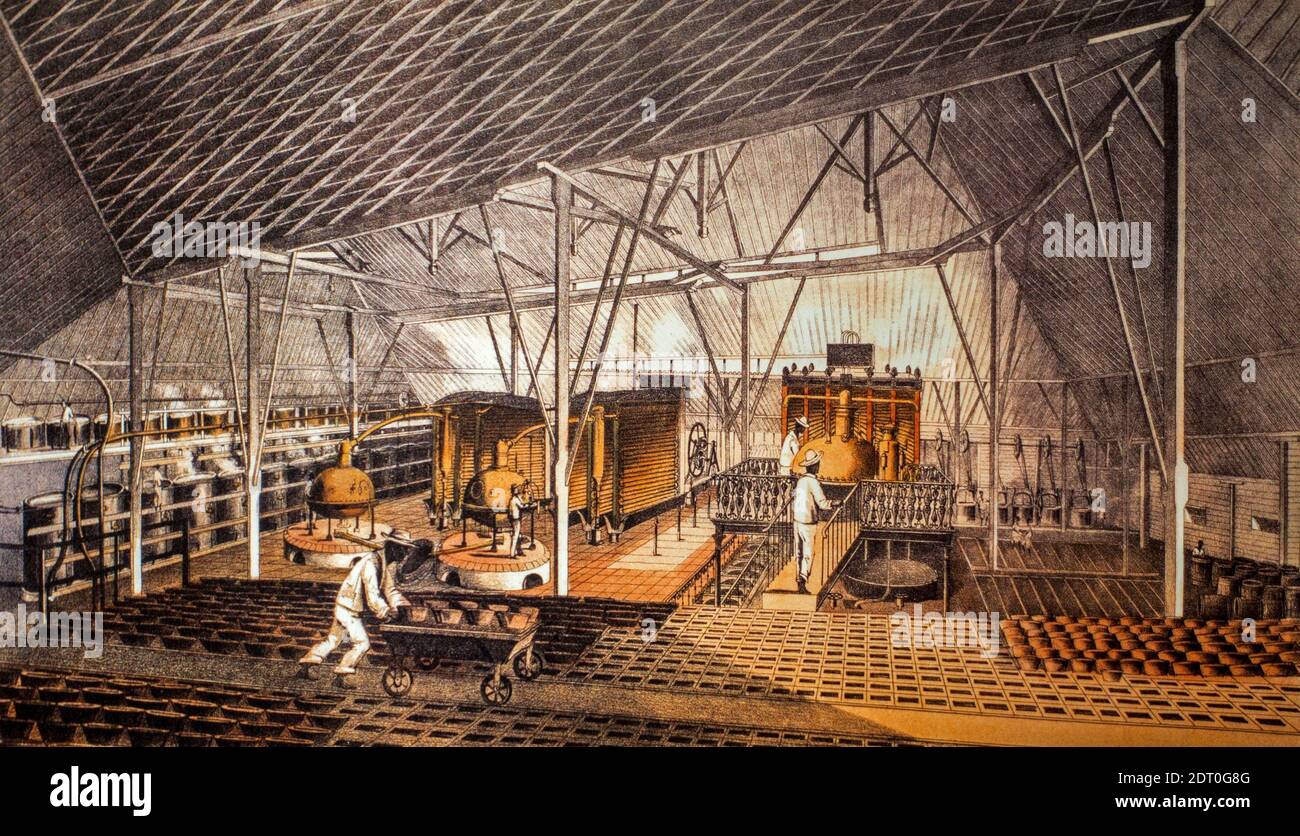 1856 lithograph showing African slaves and Chinese wage-laborers working in the La Ponina sugar factory near Cardenas, Cuba Stock Photohttps://www.alamy.com/image-license-details/?v=1https://www.alamy.com/1856-lithograph-showing-african-slaves-and-chinese-wage-laborers-working-in-the-la-ponina-sugar-factory-near-cardenas-cuba-image393392624.html
1856 lithograph showing African slaves and Chinese wage-laborers working in the La Ponina sugar factory near Cardenas, Cuba Stock Photohttps://www.alamy.com/image-license-details/?v=1https://www.alamy.com/1856-lithograph-showing-african-slaves-and-chinese-wage-laborers-working-in-the-la-ponina-sugar-factory-near-cardenas-cuba-image393392624.htmlRM2DT0G8G–1856 lithograph showing African slaves and Chinese wage-laborers working in the La Ponina sugar factory near Cardenas, Cuba
 Slave chains used to transport African slaves in the International Maritime Museum in HafenCity, Hamburg, Germany. Stock Photohttps://www.alamy.com/image-license-details/?v=1https://www.alamy.com/slave-chains-used-to-transport-african-slaves-in-the-international-maritime-museum-in-hafencity-hamburg-germany-image575531317.html
Slave chains used to transport African slaves in the International Maritime Museum in HafenCity, Hamburg, Germany. Stock Photohttps://www.alamy.com/image-license-details/?v=1https://www.alamy.com/slave-chains-used-to-transport-african-slaves-in-the-international-maritime-museum-in-hafencity-hamburg-germany-image575531317.htmlRM2TC9M1W–Slave chains used to transport African slaves in the International Maritime Museum in HafenCity, Hamburg, Germany.
 Engraving of chained African slaves in cargo hold of the slave ship Amistad, from Africa to Havana, measuring three feet and three inches high, by John Warner Barber, 1900. From the New York Public Library. Stock Photohttps://www.alamy.com/image-license-details/?v=1https://www.alamy.com/engraving-of-chained-african-slaves-in-cargo-hold-of-the-slave-ship-image155619153.html
Engraving of chained African slaves in cargo hold of the slave ship Amistad, from Africa to Havana, measuring three feet and three inches high, by John Warner Barber, 1900. From the New York Public Library. Stock Photohttps://www.alamy.com/image-license-details/?v=1https://www.alamy.com/engraving-of-chained-african-slaves-in-cargo-hold-of-the-slave-ship-image155619153.htmlRMK151PW–Engraving of chained African slaves in cargo hold of the slave ship Amistad, from Africa to Havana, measuring three feet and three inches high, by John Warner Barber, 1900. From the New York Public Library.
 View of Itamaracà Island in Brazil, 1637 Frans Post 1612-1680 Dutch Netherlands Stock Photohttps://www.alamy.com/image-license-details/?v=1https://www.alamy.com/stock-photo-view-of-itamarac-island-in-brazil-1637-frans-post-1612-1680-dutch-99363810.html
View of Itamaracà Island in Brazil, 1637 Frans Post 1612-1680 Dutch Netherlands Stock Photohttps://www.alamy.com/image-license-details/?v=1https://www.alamy.com/stock-photo-view-of-itamarac-island-in-brazil-1637-frans-post-1612-1680-dutch-99363810.htmlRMFNJBFE–View of Itamaracà Island in Brazil, 1637 Frans Post 1612-1680 Dutch Netherlands
 Slave ship diagram showing how African slaves were arranged and transported aboard the ship during the slave trade years, 1823 Stock Photohttps://www.alamy.com/image-license-details/?v=1https://www.alamy.com/slave-ship-diagram-showing-how-african-slaves-were-arranged-and-transported-aboard-the-ship-during-the-slave-trade-years-1823-image245172341.html
Slave ship diagram showing how African slaves were arranged and transported aboard the ship during the slave trade years, 1823 Stock Photohttps://www.alamy.com/image-license-details/?v=1https://www.alamy.com/slave-ship-diagram-showing-how-african-slaves-were-arranged-and-transported-aboard-the-ship-during-the-slave-trade-years-1823-image245172341.htmlRMT6TFR1–Slave ship diagram showing how African slaves were arranged and transported aboard the ship during the slave trade years, 1823
 How the Portuguese whip their slaves when they run away. Stock Photohttps://www.alamy.com/image-license-details/?v=1https://www.alamy.com/stock-photo-how-the-portuguese-whip-their-slaves-when-they-run-away-27472889.html
How the Portuguese whip their slaves when they run away. Stock Photohttps://www.alamy.com/image-license-details/?v=1https://www.alamy.com/stock-photo-how-the-portuguese-whip-their-slaves-when-they-run-away-27472889.htmlRMBGKDXH–How the Portuguese whip their slaves when they run away.
 African slaves washing for diamonds guarded by overseers with guns in Brazil. Handcoloured copperplate engraving from Gottlieb Tobias Wilhelm's Unterhaltungen aus der Naturgeschichte: Des Mineralreichs, Augsburg, 1828. Stock Photohttps://www.alamy.com/image-license-details/?v=1https://www.alamy.com/african-slaves-washing-for-diamonds-guarded-by-overseers-with-guns-in-brazil-handcoloured-copperplate-engraving-from-gottlieb-tobias-wilhelms-unterhaltungen-aus-der-naturgeschichte-des-mineralreichs-augsburg-1828-image212444798.html
African slaves washing for diamonds guarded by overseers with guns in Brazil. Handcoloured copperplate engraving from Gottlieb Tobias Wilhelm's Unterhaltungen aus der Naturgeschichte: Des Mineralreichs, Augsburg, 1828. Stock Photohttps://www.alamy.com/image-license-details/?v=1https://www.alamy.com/african-slaves-washing-for-diamonds-guarded-by-overseers-with-guns-in-brazil-handcoloured-copperplate-engraving-from-gottlieb-tobias-wilhelms-unterhaltungen-aus-der-naturgeschichte-des-mineralreichs-augsburg-1828-image212444798.htmlRMP9HKE6–African slaves washing for diamonds guarded by overseers with guns in Brazil. Handcoloured copperplate engraving from Gottlieb Tobias Wilhelm's Unterhaltungen aus der Naturgeschichte: Des Mineralreichs, Augsburg, 1828.
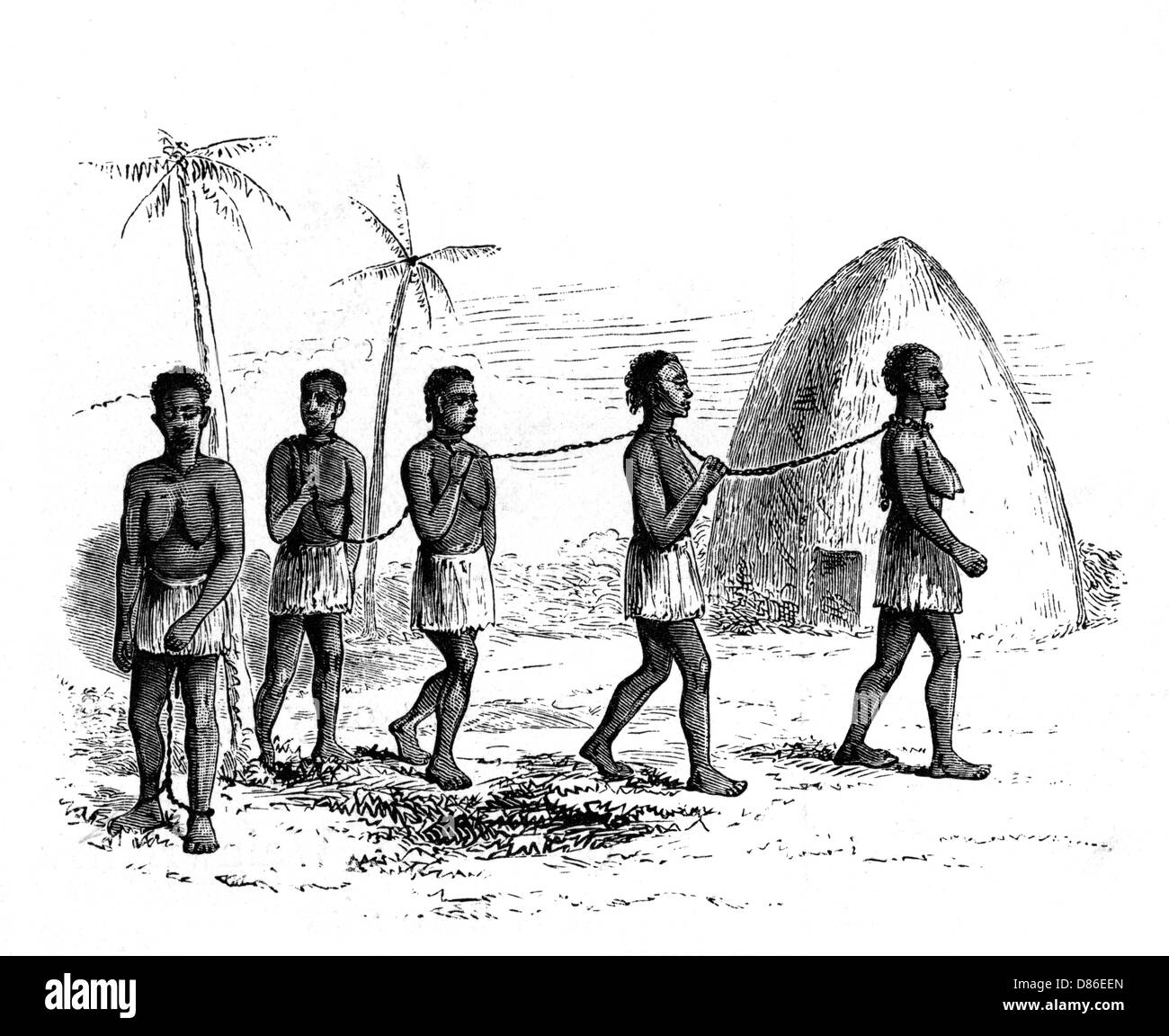 Slavery in central Africa: fettering of slaves Stock Photohttps://www.alamy.com/image-license-details/?v=1https://www.alamy.com/stock-photo-slavery-in-central-africa-fettering-of-slaves-56691453.html
Slavery in central Africa: fettering of slaves Stock Photohttps://www.alamy.com/image-license-details/?v=1https://www.alamy.com/stock-photo-slavery-in-central-africa-fettering-of-slaves-56691453.htmlRMD86EEN–Slavery in central Africa: fettering of slaves
 A memorial at the African Burial Ground National Monument in Manhattan resembles ships that brought African slaves to the U.S. Stock Photohttps://www.alamy.com/image-license-details/?v=1https://www.alamy.com/stock-photo-a-memorial-at-the-african-burial-ground-national-monument-in-manhattan-43472715.html
A memorial at the African Burial Ground National Monument in Manhattan resembles ships that brought African slaves to the U.S. Stock Photohttps://www.alamy.com/image-license-details/?v=1https://www.alamy.com/stock-photo-a-memorial-at-the-african-burial-ground-national-monument-in-manhattan-43472715.htmlRMCEM9TY–A memorial at the African Burial Ground National Monument in Manhattan resembles ships that brought African slaves to the U.S.
 Illustration showing the human cargo of a slave ship Stock Photohttps://www.alamy.com/image-license-details/?v=1https://www.alamy.com/illustration-showing-the-human-cargo-of-a-slave-ship-image377042544.html
Illustration showing the human cargo of a slave ship Stock Photohttps://www.alamy.com/image-license-details/?v=1https://www.alamy.com/illustration-showing-the-human-cargo-of-a-slave-ship-image377042544.htmlRM2CWBNH4–Illustration showing the human cargo of a slave ship
 African Slaves, Slave Traders & Slave Ship off African Coast. Vintage Illustration or Engraving 1881 Stock Photohttps://www.alamy.com/image-license-details/?v=1https://www.alamy.com/african-slaves-slave-traders-slave-ship-off-african-coast-vintage-illustration-or-engraving-1881-image460470269.html
African Slaves, Slave Traders & Slave Ship off African Coast. Vintage Illustration or Engraving 1881 Stock Photohttps://www.alamy.com/image-license-details/?v=1https://www.alamy.com/african-slaves-slave-traders-slave-ship-off-african-coast-vintage-illustration-or-engraving-1881-image460470269.htmlRM2HN46EN–African Slaves, Slave Traders & Slave Ship off African Coast. Vintage Illustration or Engraving 1881
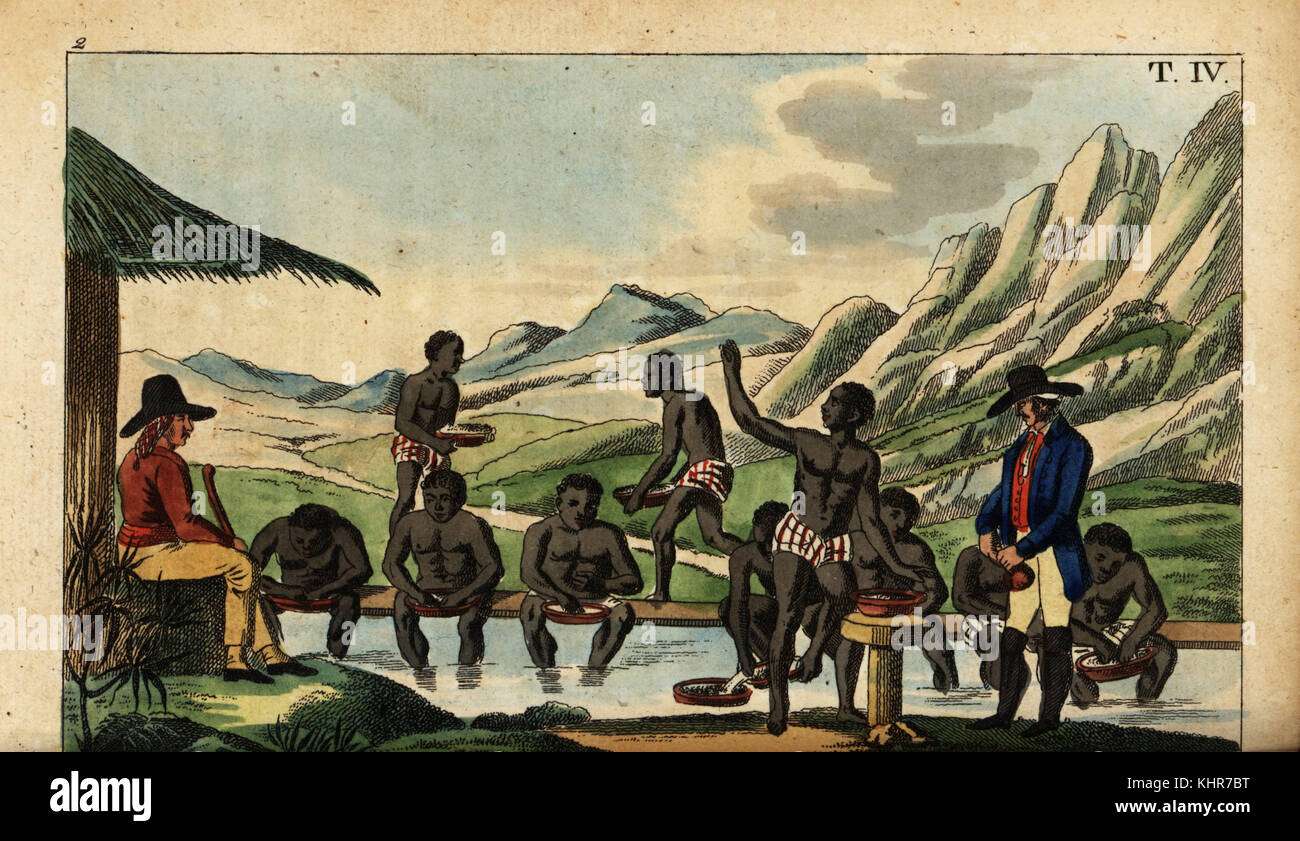 African slaves washing for diamonds guarded by overseers with guns in Brazil. Handcoloured copperplate engraving from Gottlieb Tobias Wilhelm's Unterhaltungen aus der Naturgeschichte: Des Mineralreichs, Augsburg, 1828. Stock Photohttps://www.alamy.com/image-license-details/?v=1https://www.alamy.com/stock-image-african-slaves-washing-for-diamonds-guarded-by-overseers-with-guns-165853180.html
African slaves washing for diamonds guarded by overseers with guns in Brazil. Handcoloured copperplate engraving from Gottlieb Tobias Wilhelm's Unterhaltungen aus der Naturgeschichte: Des Mineralreichs, Augsburg, 1828. Stock Photohttps://www.alamy.com/image-license-details/?v=1https://www.alamy.com/stock-image-african-slaves-washing-for-diamonds-guarded-by-overseers-with-guns-165853180.htmlRMKHR7BT–African slaves washing for diamonds guarded by overseers with guns in Brazil. Handcoloured copperplate engraving from Gottlieb Tobias Wilhelm's Unterhaltungen aus der Naturgeschichte: Des Mineralreichs, Augsburg, 1828.
 Group of African men, women and children captured and in shackles, are herded by men with whips and guns in order to become slaves. 'Band of captives driven into slavery' Stock Photohttps://www.alamy.com/image-license-details/?v=1https://www.alamy.com/group-of-african-men-women-and-children-captured-and-in-shackles-are-herded-by-men-with-whips-and-guns-in-order-to-become-slaves-band-of-captives-driven-into-slavery-image219063912.html
Group of African men, women and children captured and in shackles, are herded by men with whips and guns in order to become slaves. 'Band of captives driven into slavery' Stock Photohttps://www.alamy.com/image-license-details/?v=1https://www.alamy.com/group-of-african-men-women-and-children-captured-and-in-shackles-are-herded-by-men-with-whips-and-guns-in-order-to-become-slaves-band-of-captives-driven-into-slavery-image219063912.htmlRMPMB674–Group of African men, women and children captured and in shackles, are herded by men with whips and guns in order to become slaves. 'Band of captives driven into slavery'
 Implements of torture used in the African slave trade. Hand-colored woodcut Stock Photohttps://www.alamy.com/image-license-details/?v=1https://www.alamy.com/stock-photo-implements-of-torture-used-in-the-african-slave-trade-hand-colored-59754821.html
Implements of torture used in the African slave trade. Hand-colored woodcut Stock Photohttps://www.alamy.com/image-license-details/?v=1https://www.alamy.com/stock-photo-implements-of-torture-used-in-the-african-slave-trade-hand-colored-59754821.htmlRMDD61TN–Implements of torture used in the African slave trade. Hand-colored woodcut
 Section of the slave ship Brookes designed to show the suffering of African slaves transported in the Middle Passage during the transatlantic slave trade. This famous illustration first published in 1787 was widely disseminated and did much to advance the abolitionist cause by showing the inhumanity of the slave trade. Stock Photohttps://www.alamy.com/image-license-details/?v=1https://www.alamy.com/section-of-the-slave-ship-brookes-designed-to-show-the-suffering-of-african-slaves-transported-in-the-middle-passage-during-the-transatlantic-slave-trade-this-famous-illustration-first-published-in-1787-was-widely-disseminated-and-did-much-to-advance-the-abolitionist-cause-by-showing-the-inhumanity-of-the-slave-trade-image361908905.html
Section of the slave ship Brookes designed to show the suffering of African slaves transported in the Middle Passage during the transatlantic slave trade. This famous illustration first published in 1787 was widely disseminated and did much to advance the abolitionist cause by showing the inhumanity of the slave trade. Stock Photohttps://www.alamy.com/image-license-details/?v=1https://www.alamy.com/section-of-the-slave-ship-brookes-designed-to-show-the-suffering-of-african-slaves-transported-in-the-middle-passage-during-the-transatlantic-slave-trade-this-famous-illustration-first-published-in-1787-was-widely-disseminated-and-did-much-to-advance-the-abolitionist-cause-by-showing-the-inhumanity-of-the-slave-trade-image361908905.htmlRM2C0PAE1–Section of the slave ship Brookes designed to show the suffering of African slaves transported in the Middle Passage during the transatlantic slave trade. This famous illustration first published in 1787 was widely disseminated and did much to advance the abolitionist cause by showing the inhumanity of the slave trade.
 Brazil Coastline, Sugar Industry, 1647 Stock Photohttps://www.alamy.com/image-license-details/?v=1https://www.alamy.com/brazil-coastline-sugar-industry-1647-image352794551.html
Brazil Coastline, Sugar Industry, 1647 Stock Photohttps://www.alamy.com/image-license-details/?v=1https://www.alamy.com/brazil-coastline-sugar-industry-1647-image352794551.htmlRM2BDY51B–Brazil Coastline, Sugar Industry, 1647
 Central Africa: An Arab slaver with a coffle of slaves. Illustration from the newspaper 'L'Illustration', 1849. Black slaves were imported into the Muslim world from Africa by a number of routes northward across the Sahara desert, and by sea into Arabia and the Persian Gulf. Estimates of the number involved vary greatly but it seems that there may easily have been 10 million, perhaps even twice that number. Two-thirds of African slaves were female, as male slaves were considered to be troublesome. Stock Photohttps://www.alamy.com/image-license-details/?v=1https://www.alamy.com/central-africa-an-arab-slaver-with-a-coffle-of-slaves-illustration-from-the-newspaper-lillustration-1849-black-slaves-were-imported-into-the-muslim-world-from-africa-by-a-number-of-routes-northward-across-the-sahara-desert-and-by-sea-into-arabia-and-the-persian-gulf-estimates-of-the-number-involved-vary-greatly-but-it-seems-that-there-may-easily-have-been-10-million-perhaps-even-twice-that-number-two-thirds-of-african-slaves-were-female-as-male-slaves-were-considered-to-be-troublesome-image344238124.html
Central Africa: An Arab slaver with a coffle of slaves. Illustration from the newspaper 'L'Illustration', 1849. Black slaves were imported into the Muslim world from Africa by a number of routes northward across the Sahara desert, and by sea into Arabia and the Persian Gulf. Estimates of the number involved vary greatly but it seems that there may easily have been 10 million, perhaps even twice that number. Two-thirds of African slaves were female, as male slaves were considered to be troublesome. Stock Photohttps://www.alamy.com/image-license-details/?v=1https://www.alamy.com/central-africa-an-arab-slaver-with-a-coffle-of-slaves-illustration-from-the-newspaper-lillustration-1849-black-slaves-were-imported-into-the-muslim-world-from-africa-by-a-number-of-routes-northward-across-the-sahara-desert-and-by-sea-into-arabia-and-the-persian-gulf-estimates-of-the-number-involved-vary-greatly-but-it-seems-that-there-may-easily-have-been-10-million-perhaps-even-twice-that-number-two-thirds-of-african-slaves-were-female-as-male-slaves-were-considered-to-be-troublesome-image344238124.htmlRM2B01B6M–Central Africa: An Arab slaver with a coffle of slaves. Illustration from the newspaper 'L'Illustration', 1849. Black slaves were imported into the Muslim world from Africa by a number of routes northward across the Sahara desert, and by sea into Arabia and the Persian Gulf. Estimates of the number involved vary greatly but it seems that there may easily have been 10 million, perhaps even twice that number. Two-thirds of African slaves were female, as male slaves were considered to be troublesome.
 African slaves processing sugar cane on Hispaniola. 1595 engraving by Theodor de Bry show harvesting the cane, a slave powered Stock Photohttps://www.alamy.com/image-license-details/?v=1https://www.alamy.com/stock-photo-african-slaves-processing-sugar-cane-on-hispaniola-1595-engraving-50046445.html
African slaves processing sugar cane on Hispaniola. 1595 engraving by Theodor de Bry show harvesting the cane, a slave powered Stock Photohttps://www.alamy.com/image-license-details/?v=1https://www.alamy.com/stock-photo-african-slaves-processing-sugar-cane-on-hispaniola-1595-engraving-50046445.htmlRMCWBPN1–African slaves processing sugar cane on Hispaniola. 1595 engraving by Theodor de Bry show harvesting the cane, a slave powered
 People watch a display of Capoeira a Brazilian martial art created in the 1500's by African slaves in the Buzios market place Stock Photohttps://www.alamy.com/image-license-details/?v=1https://www.alamy.com/stock-photo-people-watch-a-display-of-capoeira-a-brazilian-martial-art-created-31794049.html
People watch a display of Capoeira a Brazilian martial art created in the 1500's by African slaves in the Buzios market place Stock Photohttps://www.alamy.com/image-license-details/?v=1https://www.alamy.com/stock-photo-people-watch-a-display-of-capoeira-a-brazilian-martial-art-created-31794049.htmlRMBRM9HN–People watch a display of Capoeira a Brazilian martial art created in the 1500's by African slaves in the Buzios market place
 1890s UK African Slaves Book Plate Stock Photohttps://www.alamy.com/image-license-details/?v=1https://www.alamy.com/stock-photo-1890s-uk-african-slaves-book-plate-85317211.html
1890s UK African Slaves Book Plate Stock Photohttps://www.alamy.com/image-license-details/?v=1https://www.alamy.com/stock-photo-1890s-uk-african-slaves-book-plate-85317211.htmlRMEXPEY7–1890s UK African Slaves Book Plate
 Slave chains used to transport African slaves in the International Maritime Museum in HafenCity, Hamburg, Germany. Stock Photohttps://www.alamy.com/image-license-details/?v=1https://www.alamy.com/slave-chains-used-to-transport-african-slaves-in-the-international-maritime-museum-in-hafencity-hamburg-germany-image575531322.html
Slave chains used to transport African slaves in the International Maritime Museum in HafenCity, Hamburg, Germany. Stock Photohttps://www.alamy.com/image-license-details/?v=1https://www.alamy.com/slave-chains-used-to-transport-african-slaves-in-the-international-maritime-museum-in-hafencity-hamburg-germany-image575531322.htmlRM2TC9M22–Slave chains used to transport African slaves in the International Maritime Museum in HafenCity, Hamburg, Germany.
 88 A series of statistical charts illustrating the condition of the descendants of former African slaves now in residence in the United States of America LCCN2014645360 Stock Photohttps://www.alamy.com/image-license-details/?v=1https://www.alamy.com/88-a-series-of-statistical-charts-illustrating-the-condition-of-the-descendants-of-former-african-slaves-now-in-residence-in-the-united-states-of-america-lccn2014645360-image212753713.html
88 A series of statistical charts illustrating the condition of the descendants of former African slaves now in residence in the United States of America LCCN2014645360 Stock Photohttps://www.alamy.com/image-license-details/?v=1https://www.alamy.com/88-a-series-of-statistical-charts-illustrating-the-condition-of-the-descendants-of-former-african-slaves-now-in-residence-in-the-united-states-of-america-lccn2014645360-image212753713.htmlRMPA3NEW–88 A series of statistical charts illustrating the condition of the descendants of former African slaves now in residence in the United States of America LCCN2014645360
 Joseph Cinquez was the leader of a revolt among African slaves aboard the Spanish ship 'Amistad' en route to Cuba in June 1839. The slaves seized control of the ship but were soon recaptured and charged with murder and piracy. This portrait was done while Cinquez (or 'Cinque') awaited trial in New Haven, Connecticut. John Quincy Adams represented the Africans before the Supreme Court, and thanks to his eloquence, they were set free and allowed to return to Africa. Stock Photohttps://www.alamy.com/image-license-details/?v=1https://www.alamy.com/joseph-cinquez-was-the-leader-of-a-revolt-among-african-slaves-aboard-the-spanish-ship-amistad-en-route-to-cuba-in-june-1839-the-slaves-seized-control-of-the-ship-but-were-soon-recaptured-and-charged-with-murder-and-piracy-this-portrait-was-done-while-cinquez-or-cinque-awaited-trial-in-new-haven-connecticut-john-quincy-adams-represented-the-africans-before-the-supreme-court-and-thanks-to-his-eloquence-they-were-set-free-and-allowed-to-return-to-africa-image235129964.html
Joseph Cinquez was the leader of a revolt among African slaves aboard the Spanish ship 'Amistad' en route to Cuba in June 1839. The slaves seized control of the ship but were soon recaptured and charged with murder and piracy. This portrait was done while Cinquez (or 'Cinque') awaited trial in New Haven, Connecticut. John Quincy Adams represented the Africans before the Supreme Court, and thanks to his eloquence, they were set free and allowed to return to Africa. Stock Photohttps://www.alamy.com/image-license-details/?v=1https://www.alamy.com/joseph-cinquez-was-the-leader-of-a-revolt-among-african-slaves-aboard-the-spanish-ship-amistad-en-route-to-cuba-in-june-1839-the-slaves-seized-control-of-the-ship-but-were-soon-recaptured-and-charged-with-murder-and-piracy-this-portrait-was-done-while-cinquez-or-cinque-awaited-trial-in-new-haven-connecticut-john-quincy-adams-represented-the-africans-before-the-supreme-court-and-thanks-to-his-eloquence-they-were-set-free-and-allowed-to-return-to-africa-image235129964.htmlRMRJF2JM–Joseph Cinquez was the leader of a revolt among African slaves aboard the Spanish ship 'Amistad' en route to Cuba in June 1839. The slaves seized control of the ship but were soon recaptured and charged with murder and piracy. This portrait was done while Cinquez (or 'Cinque') awaited trial in New Haven, Connecticut. John Quincy Adams represented the Africans before the Supreme Court, and thanks to his eloquence, they were set free and allowed to return to Africa.
 White Slave Traders branding captured African female slaves, engraving, 1859 Stock Photohttps://www.alamy.com/image-license-details/?v=1https://www.alamy.com/white-slave-traders-branding-captured-african-female-slaves-engraving-1859-image479825291.html
White Slave Traders branding captured African female slaves, engraving, 1859 Stock Photohttps://www.alamy.com/image-license-details/?v=1https://www.alamy.com/white-slave-traders-branding-captured-african-female-slaves-engraving-1859-image479825291.htmlRM2JTHX1F–White Slave Traders branding captured African female slaves, engraving, 1859
 A group of captured Africans being led away by a white slaver. Stock Photohttps://www.alamy.com/image-license-details/?v=1https://www.alamy.com/stock-photo-a-group-of-captured-africans-being-led-away-by-a-white-slaver-38107873.html
A group of captured Africans being led away by a white slaver. Stock Photohttps://www.alamy.com/image-license-details/?v=1https://www.alamy.com/stock-photo-a-group-of-captured-africans-being-led-away-by-a-white-slaver-38107873.htmlRMC5YXYD–A group of captured Africans being led away by a white slaver.
 View of the grotesque mica mountains of Villavelha, Serra do Rio de Contas, Bahia, Brazil, famous for its gold mines. In the foreground, two African slaves harvest fruit. Handcoloured copperplate engraving from Gottlieb Tobias Wilhelm's Unterhaltungen aus der Naturgeschichte: Des Mineralreichs, Augsburg, 1828. Stock Photohttps://www.alamy.com/image-license-details/?v=1https://www.alamy.com/view-of-the-grotesque-mica-mountains-of-villavelha-serra-do-rio-de-contas-bahia-brazil-famous-for-its-gold-mines-in-the-foreground-two-african-slaves-harvest-fruit-handcoloured-copperplate-engraving-from-gottlieb-tobias-wilhelms-unterhaltungen-aus-der-naturgeschichte-des-mineralreichs-augsburg-1828-image212444701.html
View of the grotesque mica mountains of Villavelha, Serra do Rio de Contas, Bahia, Brazil, famous for its gold mines. In the foreground, two African slaves harvest fruit. Handcoloured copperplate engraving from Gottlieb Tobias Wilhelm's Unterhaltungen aus der Naturgeschichte: Des Mineralreichs, Augsburg, 1828. Stock Photohttps://www.alamy.com/image-license-details/?v=1https://www.alamy.com/view-of-the-grotesque-mica-mountains-of-villavelha-serra-do-rio-de-contas-bahia-brazil-famous-for-its-gold-mines-in-the-foreground-two-african-slaves-harvest-fruit-handcoloured-copperplate-engraving-from-gottlieb-tobias-wilhelms-unterhaltungen-aus-der-naturgeschichte-des-mineralreichs-augsburg-1828-image212444701.htmlRMP9HKAN–View of the grotesque mica mountains of Villavelha, Serra do Rio de Contas, Bahia, Brazil, famous for its gold mines. In the foreground, two African slaves harvest fruit. Handcoloured copperplate engraving from Gottlieb Tobias Wilhelm's Unterhaltungen aus der Naturgeschichte: Des Mineralreichs, Augsburg, 1828.
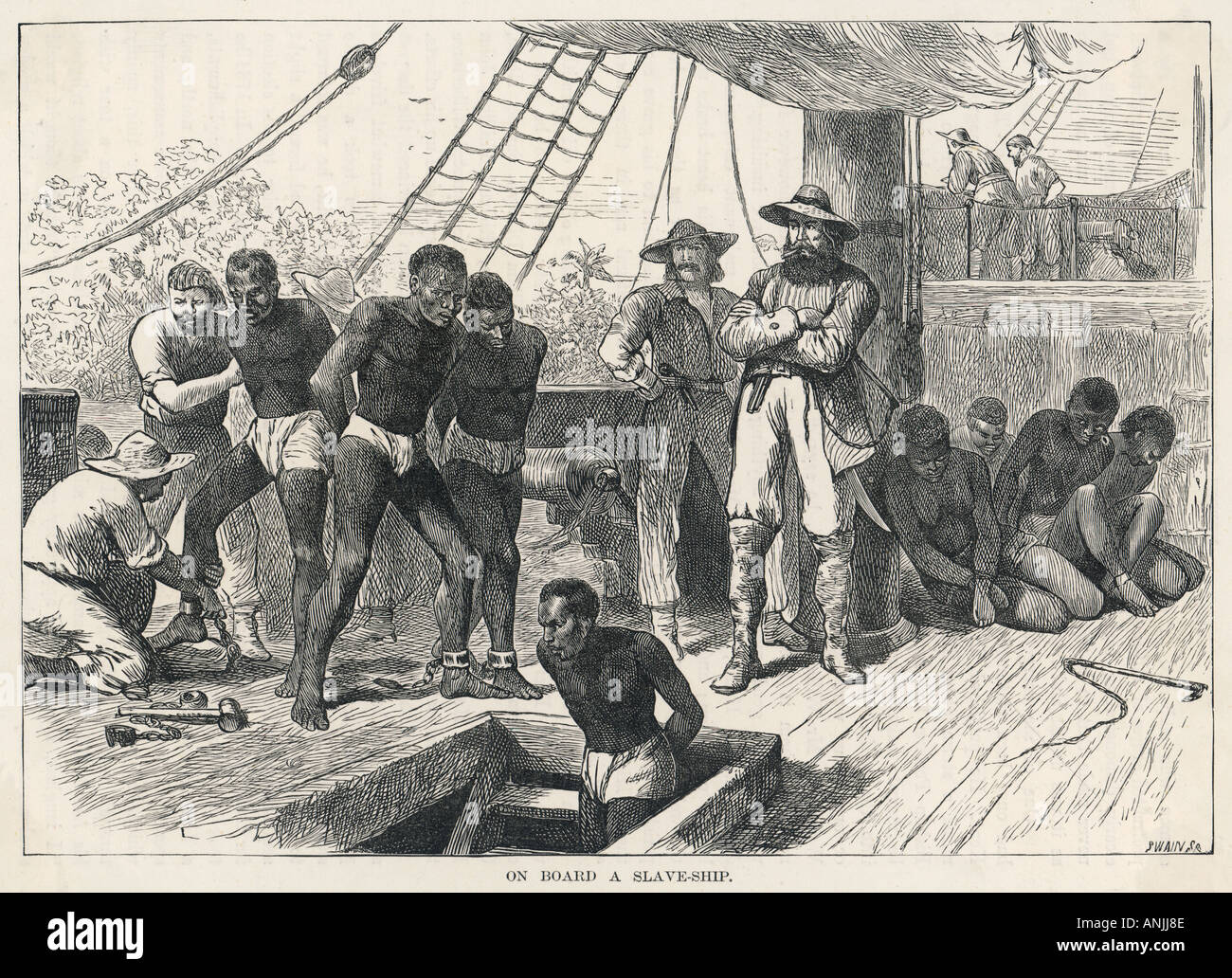 Slavery Shipboard Scenes Stock Photohttps://www.alamy.com/image-license-details/?v=1https://www.alamy.com/slavery-shipboard-scenes-image5073549.html
Slavery Shipboard Scenes Stock Photohttps://www.alamy.com/image-license-details/?v=1https://www.alamy.com/slavery-shipboard-scenes-image5073549.htmlRMANJJ8E–Slavery Shipboard Scenes
 A series of statistical charts illustrating the condition of the descendants of former African slaves now in residence in the United States of America LCCN2014645356 Stock Photohttps://www.alamy.com/image-license-details/?v=1https://www.alamy.com/stock-image-a-series-of-statistical-charts-illustrating-the-condition-of-the-descendants-162738822.html
A series of statistical charts illustrating the condition of the descendants of former African slaves now in residence in the United States of America LCCN2014645356 Stock Photohttps://www.alamy.com/image-license-details/?v=1https://www.alamy.com/stock-image-a-series-of-statistical-charts-illustrating-the-condition-of-the-descendants-162738822.htmlRMKCNB0P–A series of statistical charts illustrating the condition of the descendants of former African slaves now in residence in the United States of America LCCN2014645356
 Slaves picking cotton while watched by a white overseer on horseback, picture taken about 1850 in the southern United States Stock Photohttps://www.alamy.com/image-license-details/?v=1https://www.alamy.com/slaves-picking-cotton-while-watched-by-a-white-overseer-on-horseback-picture-taken-about-1850-in-the-southern-united-states-image634301506.html
Slaves picking cotton while watched by a white overseer on horseback, picture taken about 1850 in the southern United States Stock Photohttps://www.alamy.com/image-license-details/?v=1https://www.alamy.com/slaves-picking-cotton-while-watched-by-a-white-overseer-on-horseback-picture-taken-about-1850-in-the-southern-united-states-image634301506.htmlRM2YRXX16–Slaves picking cotton while watched by a white overseer on horseback, picture taken about 1850 in the southern United States
 African Slaves Rounded Up by Arab Slave Traders or Slave Trade Africa Vintage Illustration or Engraving 1878 (Castelli) Stock Photohttps://www.alamy.com/image-license-details/?v=1https://www.alamy.com/african-slaves-rounded-up-by-arab-slave-traders-or-slave-trade-africa-vintage-illustration-or-engraving-1878-castelli-image460796189.html
African Slaves Rounded Up by Arab Slave Traders or Slave Trade Africa Vintage Illustration or Engraving 1878 (Castelli) Stock Photohttps://www.alamy.com/image-license-details/?v=1https://www.alamy.com/african-slaves-rounded-up-by-arab-slave-traders-or-slave-trade-africa-vintage-illustration-or-engraving-1878-castelli-image460796189.htmlRM2HNK26N–African Slaves Rounded Up by Arab Slave Traders or Slave Trade Africa Vintage Illustration or Engraving 1878 (Castelli)
 View of the grotesque mica mountains of Villavelha, Serra do Rio de Contas, Bahia, Brazil, famous for its gold mines. In the foreground, two African slaves harvest fruit. Handcoloured copperplate engraving from Gottlieb Tobias Wilhelm's Unterhaltungen aus der Naturgeschichte: Des Mineralreichs, Augsburg, 1828. Stock Photohttps://www.alamy.com/image-license-details/?v=1https://www.alamy.com/stock-image-view-of-the-grotesque-mica-mountains-of-villavelha-serra-do-rio-de-165853170.html
View of the grotesque mica mountains of Villavelha, Serra do Rio de Contas, Bahia, Brazil, famous for its gold mines. In the foreground, two African slaves harvest fruit. Handcoloured copperplate engraving from Gottlieb Tobias Wilhelm's Unterhaltungen aus der Naturgeschichte: Des Mineralreichs, Augsburg, 1828. Stock Photohttps://www.alamy.com/image-license-details/?v=1https://www.alamy.com/stock-image-view-of-the-grotesque-mica-mountains-of-villavelha-serra-do-rio-de-165853170.htmlRMKHR7BE–View of the grotesque mica mountains of Villavelha, Serra do Rio de Contas, Bahia, Brazil, famous for its gold mines. In the foreground, two African slaves harvest fruit. Handcoloured copperplate engraving from Gottlieb Tobias Wilhelm's Unterhaltungen aus der Naturgeschichte: Des Mineralreichs, Augsburg, 1828.
 Pictures of African slaves on door in historic narrow streets of Centro, Rio de Janeiro, Brazil, South America Stock Photohttps://www.alamy.com/image-license-details/?v=1https://www.alamy.com/stock-image-pictures-of-african-slaves-on-door-in-historic-narrow-streets-of-centro-161293402.html
Pictures of African slaves on door in historic narrow streets of Centro, Rio de Janeiro, Brazil, South America Stock Photohttps://www.alamy.com/image-license-details/?v=1https://www.alamy.com/stock-image-pictures-of-african-slaves-on-door-in-historic-narrow-streets-of-centro-161293402.htmlRMKABFAJ–Pictures of African slaves on door in historic narrow streets of Centro, Rio de Janeiro, Brazil, South America
 African-American slaves loading cotton on the levee at New Orleans 1850s. Hand-colored woodcut Stock Photohttps://www.alamy.com/image-license-details/?v=1https://www.alamy.com/african-american-slaves-loading-cotton-on-the-levee-at-new-orleans-image7713254.html
African-American slaves loading cotton on the levee at New Orleans 1850s. Hand-colored woodcut Stock Photohttps://www.alamy.com/image-license-details/?v=1https://www.alamy.com/african-american-slaves-loading-cotton-on-the-levee-at-new-orleans-image7713254.htmlRMADWBX7–African-American slaves loading cotton on the levee at New Orleans 1850s. Hand-colored woodcut
 Edward Colston (1636-1721) English merchant and philanthropist who did much to improve his native city of Bristol. Colston was involvement in the management of the Royal African Company between 1689-92 which has a monopoly on the transatlantic transportation and sale African slaves in the Americas. Engraving by George Vertue (1684-1756) published in 1722. Stock Photohttps://www.alamy.com/image-license-details/?v=1https://www.alamy.com/edward-colston-1636-1721-english-merchant-and-philanthropist-who-did-much-to-improve-his-native-city-of-bristol-colston-was-involvement-in-the-management-of-the-royal-african-company-between-1689-92-which-has-a-monopoly-on-the-transatlantic-transportation-and-sale-african-slaves-in-the-americas-engraving-by-george-vertue-1684-1756-published-in-1722-image361676822.html
Edward Colston (1636-1721) English merchant and philanthropist who did much to improve his native city of Bristol. Colston was involvement in the management of the Royal African Company between 1689-92 which has a monopoly on the transatlantic transportation and sale African slaves in the Americas. Engraving by George Vertue (1684-1756) published in 1722. Stock Photohttps://www.alamy.com/image-license-details/?v=1https://www.alamy.com/edward-colston-1636-1721-english-merchant-and-philanthropist-who-did-much-to-improve-his-native-city-of-bristol-colston-was-involvement-in-the-management-of-the-royal-african-company-between-1689-92-which-has-a-monopoly-on-the-transatlantic-transportation-and-sale-african-slaves-in-the-americas-engraving-by-george-vertue-1684-1756-published-in-1722-image361676822.htmlRM2C0BPDA–Edward Colston (1636-1721) English merchant and philanthropist who did much to improve his native city of Bristol. Colston was involvement in the management of the Royal African Company between 1689-92 which has a monopoly on the transatlantic transportation and sale African slaves in the Americas. Engraving by George Vertue (1684-1756) published in 1722.
 Brookes, English Slave Ship, 1788 Stock Photohttps://www.alamy.com/image-license-details/?v=1https://www.alamy.com/brookes-english-slave-ship-1788-image352772592.html
Brookes, English Slave Ship, 1788 Stock Photohttps://www.alamy.com/image-license-details/?v=1https://www.alamy.com/brookes-english-slave-ship-1788-image352772592.htmlRM2BDX514–Brookes, English Slave Ship, 1788
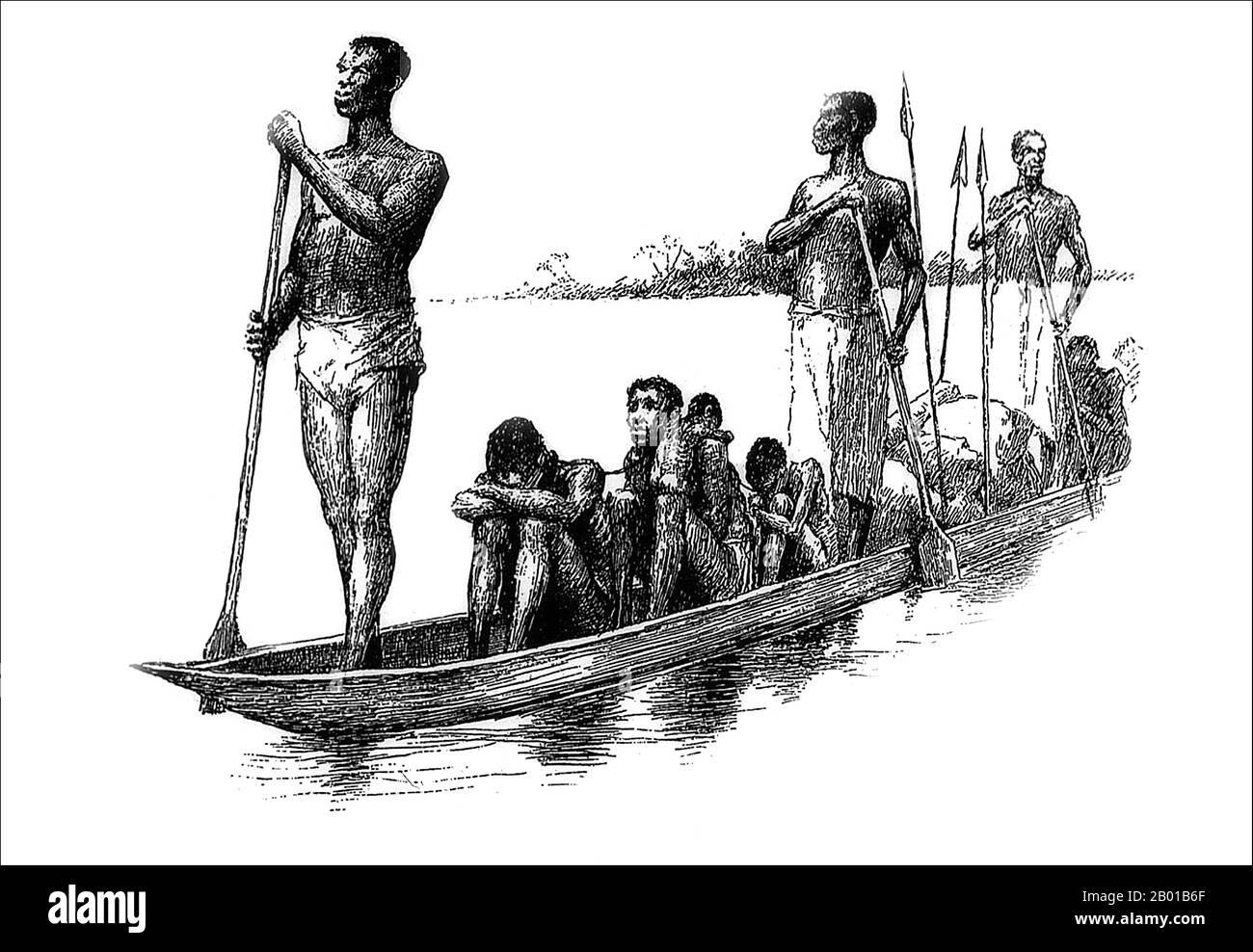 Central Africa: Captured slaves being transported across a river by canoe. Illustration by Edward Winsor Kemble (18 January 1861 - 19 September 1933), 1880s. Black slaves were imported into the Muslim world from Africa by a number of routes northward across the Sahara desert, and by sea into Arabia and the Persian Gulf. Estimates of the number involved vary greatly but it seems that there may easily have been 10 million, perhaps even twice that number. Two-thirds of African slaves were female. The males were considered to be troublesome. Stock Photohttps://www.alamy.com/image-license-details/?v=1https://www.alamy.com/central-africa-captured-slaves-being-transported-across-a-river-by-canoe-illustration-by-edward-winsor-kemble-18-january-1861-19-september-1933-1880s-black-slaves-were-imported-into-the-muslim-world-from-africa-by-a-number-of-routes-northward-across-the-sahara-desert-and-by-sea-into-arabia-and-the-persian-gulf-estimates-of-the-number-involved-vary-greatly-but-it-seems-that-there-may-easily-have-been-10-million-perhaps-even-twice-that-number-two-thirds-of-african-slaves-were-female-the-males-were-considered-to-be-troublesome-image344238119.html
Central Africa: Captured slaves being transported across a river by canoe. Illustration by Edward Winsor Kemble (18 January 1861 - 19 September 1933), 1880s. Black slaves were imported into the Muslim world from Africa by a number of routes northward across the Sahara desert, and by sea into Arabia and the Persian Gulf. Estimates of the number involved vary greatly but it seems that there may easily have been 10 million, perhaps even twice that number. Two-thirds of African slaves were female. The males were considered to be troublesome. Stock Photohttps://www.alamy.com/image-license-details/?v=1https://www.alamy.com/central-africa-captured-slaves-being-transported-across-a-river-by-canoe-illustration-by-edward-winsor-kemble-18-january-1861-19-september-1933-1880s-black-slaves-were-imported-into-the-muslim-world-from-africa-by-a-number-of-routes-northward-across-the-sahara-desert-and-by-sea-into-arabia-and-the-persian-gulf-estimates-of-the-number-involved-vary-greatly-but-it-seems-that-there-may-easily-have-been-10-million-perhaps-even-twice-that-number-two-thirds-of-african-slaves-were-female-the-males-were-considered-to-be-troublesome-image344238119.htmlRM2B01B6F–Central Africa: Captured slaves being transported across a river by canoe. Illustration by Edward Winsor Kemble (18 January 1861 - 19 September 1933), 1880s. Black slaves were imported into the Muslim world from Africa by a number of routes northward across the Sahara desert, and by sea into Arabia and the Persian Gulf. Estimates of the number involved vary greatly but it seems that there may easily have been 10 million, perhaps even twice that number. Two-thirds of African slaves were female. The males were considered to be troublesome.
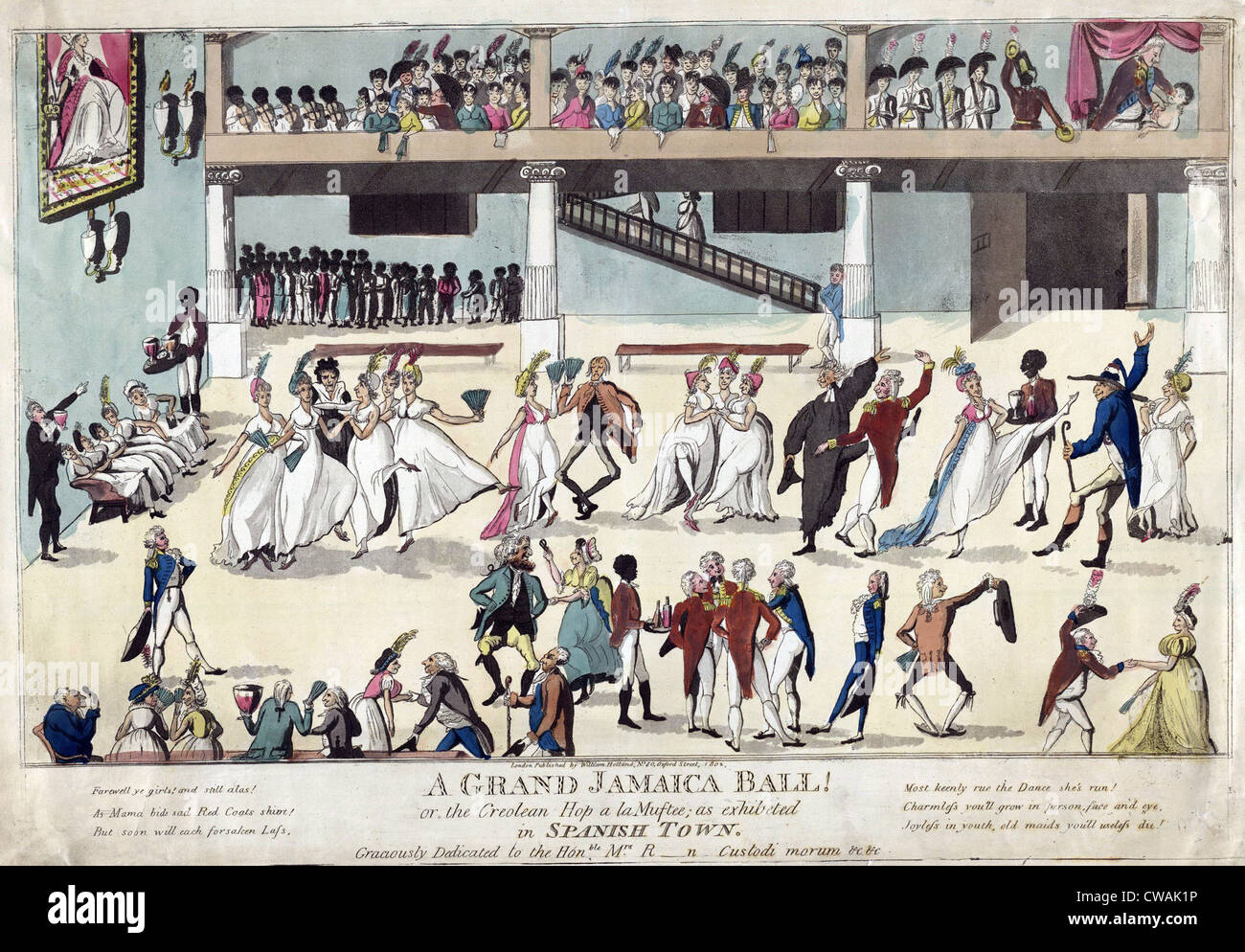 British colonists dancing and served by African slaves at a ball in Spanish Town, Jamaica. The print six lines of verse warning Stock Photohttps://www.alamy.com/image-license-details/?v=1https://www.alamy.com/stock-photo-british-colonists-dancing-and-served-by-african-slaves-at-a-ball-in-50021602.html
British colonists dancing and served by African slaves at a ball in Spanish Town, Jamaica. The print six lines of verse warning Stock Photohttps://www.alamy.com/image-license-details/?v=1https://www.alamy.com/stock-photo-british-colonists-dancing-and-served-by-african-slaves-at-a-ball-in-50021602.htmlRMCWAK1P–British colonists dancing and served by African slaves at a ball in Spanish Town, Jamaica. The print six lines of verse warning
 1909 book illustration, landing black slaves at Jamestown from the 'White Lion' in 1619. The Colony of Virginia was the first permanent English settlement in the Americas. The first documented African slaves from the frigate 'White Lion' in 1619, black Africans Antoney and Isabella who took the surname Tucker. Their child William Tucker, became the first documented African baptized in British North America. Stock Photohttps://www.alamy.com/image-license-details/?v=1https://www.alamy.com/1909-book-illustration-landing-black-slaves-at-jamestown-from-the-white-lion-in-1619-the-colony-of-virginia-was-the-first-permanent-english-settlement-in-the-americas-the-first-documented-african-slaves-from-the-frigate-white-lion-in-1619-black-africans-antoney-and-isabella-who-took-the-surname-tucker-their-child-william-tucker-became-the-first-documented-african-baptized-in-british-north-america-image345466025.html
1909 book illustration, landing black slaves at Jamestown from the 'White Lion' in 1619. The Colony of Virginia was the first permanent English settlement in the Americas. The first documented African slaves from the frigate 'White Lion' in 1619, black Africans Antoney and Isabella who took the surname Tucker. Their child William Tucker, became the first documented African baptized in British North America. Stock Photohttps://www.alamy.com/image-license-details/?v=1https://www.alamy.com/1909-book-illustration-landing-black-slaves-at-jamestown-from-the-white-lion-in-1619-the-colony-of-virginia-was-the-first-permanent-english-settlement-in-the-americas-the-first-documented-african-slaves-from-the-frigate-white-lion-in-1619-black-africans-antoney-and-isabella-who-took-the-surname-tucker-their-child-william-tucker-became-the-first-documented-african-baptized-in-british-north-america-image345466025.htmlRM2B219C9–1909 book illustration, landing black slaves at Jamestown from the 'White Lion' in 1619. The Colony of Virginia was the first permanent English settlement in the Americas. The first documented African slaves from the frigate 'White Lion' in 1619, black Africans Antoney and Isabella who took the surname Tucker. Their child William Tucker, became the first documented African baptized in British North America.
 United States slave states advocated annexing Cuba. An 1850's illustration shows a Cuban tobacco plantation with African slaves. Stock Photohttps://www.alamy.com/image-license-details/?v=1https://www.alamy.com/stock-photo-united-states-slave-states-advocated-annexing-cuba-an-1850s-illustration-32382426.html
United States slave states advocated annexing Cuba. An 1850's illustration shows a Cuban tobacco plantation with African slaves. Stock Photohttps://www.alamy.com/image-license-details/?v=1https://www.alamy.com/stock-photo-united-states-slave-states-advocated-annexing-cuba-an-1850s-illustration-32382426.htmlRMBTK436–United States slave states advocated annexing Cuba. An 1850's illustration shows a Cuban tobacco plantation with African slaves.
 Showing how Slaves are Yoked a photograph from the book ' The history of the Universities' Mission to Central Africa, 1859-1898 ' by Anne Elizabeth Mary Anderson Morshead, Universities' Mission to Central Africa 1899 Stock Photohttps://www.alamy.com/image-license-details/?v=1https://www.alamy.com/showing-how-slaves-are-yoked-a-photograph-from-the-book-the-history-of-the-universities-mission-to-central-africa-1859-1898-by-anne-elizabeth-mary-anderson-morshead-universities-mission-to-central-africa-1899-image456333570.html
Showing how Slaves are Yoked a photograph from the book ' The history of the Universities' Mission to Central Africa, 1859-1898 ' by Anne Elizabeth Mary Anderson Morshead, Universities' Mission to Central Africa 1899 Stock Photohttps://www.alamy.com/image-license-details/?v=1https://www.alamy.com/showing-how-slaves-are-yoked-a-photograph-from-the-book-the-history-of-the-universities-mission-to-central-africa-1859-1898-by-anne-elizabeth-mary-anderson-morshead-universities-mission-to-central-africa-1899-image456333570.htmlRF2HEBP3E–Showing how Slaves are Yoked a photograph from the book ' The history of the Universities' Mission to Central Africa, 1859-1898 ' by Anne Elizabeth Mary Anderson Morshead, Universities' Mission to Central Africa 1899
 88 A series of statistical charts illustrating the condition of the descendants of former African slaves now in residence in the United States of America LCCN2014645363 Stock Photohttps://www.alamy.com/image-license-details/?v=1https://www.alamy.com/88-a-series-of-statistical-charts-illustrating-the-condition-of-the-descendants-of-former-african-slaves-now-in-residence-in-the-united-states-of-america-lccn2014645363-image212753717.html
88 A series of statistical charts illustrating the condition of the descendants of former African slaves now in residence in the United States of America LCCN2014645363 Stock Photohttps://www.alamy.com/image-license-details/?v=1https://www.alamy.com/88-a-series-of-statistical-charts-illustrating-the-condition-of-the-descendants-of-former-african-slaves-now-in-residence-in-the-united-states-of-america-lccn2014645363-image212753717.htmlRMPA3NF1–88 A series of statistical charts illustrating the condition of the descendants of former African slaves now in residence in the United States of America LCCN2014645363
 Painet iy8083 brazil girl kid child castainho quilombo pernambuco people living quilombos descendants african slaves 2005 Stock Photohttps://www.alamy.com/image-license-details/?v=1https://www.alamy.com/stock-photo-painet-iy8083-brazil-girl-kid-child-castainho-quilombo-pernambuco-11211280.html
Painet iy8083 brazil girl kid child castainho quilombo pernambuco people living quilombos descendants african slaves 2005 Stock Photohttps://www.alamy.com/image-license-details/?v=1https://www.alamy.com/stock-photo-painet-iy8083-brazil-girl-kid-child-castainho-quilombo-pernambuco-11211280.htmlRFA569GH–Painet iy8083 brazil girl kid child castainho quilombo pernambuco people living quilombos descendants african slaves 2005
 Force feeding African male slaves on board a Transatlantic Slave Ship, print, 1900 Stock Photohttps://www.alamy.com/image-license-details/?v=1https://www.alamy.com/force-feeding-african-male-slaves-on-board-a-transatlantic-slave-ship-print-1900-image479825341.html
Force feeding African male slaves on board a Transatlantic Slave Ship, print, 1900 Stock Photohttps://www.alamy.com/image-license-details/?v=1https://www.alamy.com/force-feeding-african-male-slaves-on-board-a-transatlantic-slave-ship-print-1900-image479825341.htmlRM2JTHX39–Force feeding African male slaves on board a Transatlantic Slave Ship, print, 1900
 A racial miscellany (left) an Itapirape Indian a south American aboriginal; (centre) a descendant of imported African slaves; right, a Brazilian descendant of the first Portuguese settlers (head only visible). - 10 September 1932 Stock Photohttps://www.alamy.com/image-license-details/?v=1https://www.alamy.com/a-racial-miscellany-left-an-itapirape-indian-a-south-american-aboriginal-centre-a-descendant-of-imported-african-slaves-right-a-brazilian-descendant-of-the-first-portuguese-settlers-head-only-visible-10-september-1932-image623688250.html
A racial miscellany (left) an Itapirape Indian a south American aboriginal; (centre) a descendant of imported African slaves; right, a Brazilian descendant of the first Portuguese settlers (head only visible). - 10 September 1932 Stock Photohttps://www.alamy.com/image-license-details/?v=1https://www.alamy.com/a-racial-miscellany-left-an-itapirape-indian-a-south-american-aboriginal-centre-a-descendant-of-imported-african-slaves-right-a-brazilian-descendant-of-the-first-portuguese-settlers-head-only-visible-10-september-1932-image623688250.htmlRM2Y6KCMA–A racial miscellany (left) an Itapirape Indian a south American aboriginal; (centre) a descendant of imported African slaves; right, a Brazilian descendant of the first Portuguese settlers (head only visible). - 10 September 1932
 African slaves washing for diamonds at Mandanga on the River Jigitonhonha in Cerro de Frio, Brazil. From John Mawe's Travels in the Interior of Brazil, 1812. Copperplate engraving by Dall'Acqua handcoloured by Laxaretti from Giovanni Battista Sonzogno's Raccolta de Viaggi Piu Interessanti, Milan, 1815. Stock Photohttps://www.alamy.com/image-license-details/?v=1https://www.alamy.com/african-slaves-washing-for-diamonds-at-mandanga-on-the-river-jigitonhonha-in-cerro-de-frio-brazil-from-john-mawes-travels-in-the-interior-of-brazil-1812-copperplate-engraving-by-dallacqua-handcoloured-by-laxaretti-from-giovanni-battista-sonzognos-raccolta-de-viaggi-piu-interessanti-milan-1815-image212436713.html
African slaves washing for diamonds at Mandanga on the River Jigitonhonha in Cerro de Frio, Brazil. From John Mawe's Travels in the Interior of Brazil, 1812. Copperplate engraving by Dall'Acqua handcoloured by Laxaretti from Giovanni Battista Sonzogno's Raccolta de Viaggi Piu Interessanti, Milan, 1815. Stock Photohttps://www.alamy.com/image-license-details/?v=1https://www.alamy.com/african-slaves-washing-for-diamonds-at-mandanga-on-the-river-jigitonhonha-in-cerro-de-frio-brazil-from-john-mawes-travels-in-the-interior-of-brazil-1812-copperplate-engraving-by-dallacqua-handcoloured-by-laxaretti-from-giovanni-battista-sonzognos-raccolta-de-viaggi-piu-interessanti-milan-1815-image212436713.htmlRMP9H95D–African slaves washing for diamonds at Mandanga on the River Jigitonhonha in Cerro de Frio, Brazil. From John Mawe's Travels in the Interior of Brazil, 1812. Copperplate engraving by Dall'Acqua handcoloured by Laxaretti from Giovanni Battista Sonzogno's Raccolta de Viaggi Piu Interessanti, Milan, 1815.
 WEST AFRICA Embarking slaves from the African coast for shipment to the Americas Date: 1865 Stock Photohttps://www.alamy.com/image-license-details/?v=1https://www.alamy.com/stock-photo-west-africa-embarking-slaves-from-the-african-coast-for-shipment-to-105277922.html
WEST AFRICA Embarking slaves from the African coast for shipment to the Americas Date: 1865 Stock Photohttps://www.alamy.com/image-license-details/?v=1https://www.alamy.com/stock-photo-west-africa-embarking-slaves-from-the-african-coast-for-shipment-to-105277922.htmlRMG37R1P–WEST AFRICA Embarking slaves from the African coast for shipment to the Americas Date: 1865
 A series of statistical charts illustrating the condition of the descendants of former African slaves now in residence in the United States of America LCCN2014645354 Stock Photohttps://www.alamy.com/image-license-details/?v=1https://www.alamy.com/stock-image-a-series-of-statistical-charts-illustrating-the-condition-of-the-descendants-162738820.html
A series of statistical charts illustrating the condition of the descendants of former African slaves now in residence in the United States of America LCCN2014645354 Stock Photohttps://www.alamy.com/image-license-details/?v=1https://www.alamy.com/stock-image-a-series-of-statistical-charts-illustrating-the-condition-of-the-descendants-162738820.htmlRMKCNB0M–A series of statistical charts illustrating the condition of the descendants of former African slaves now in residence in the United States of America LCCN2014645354
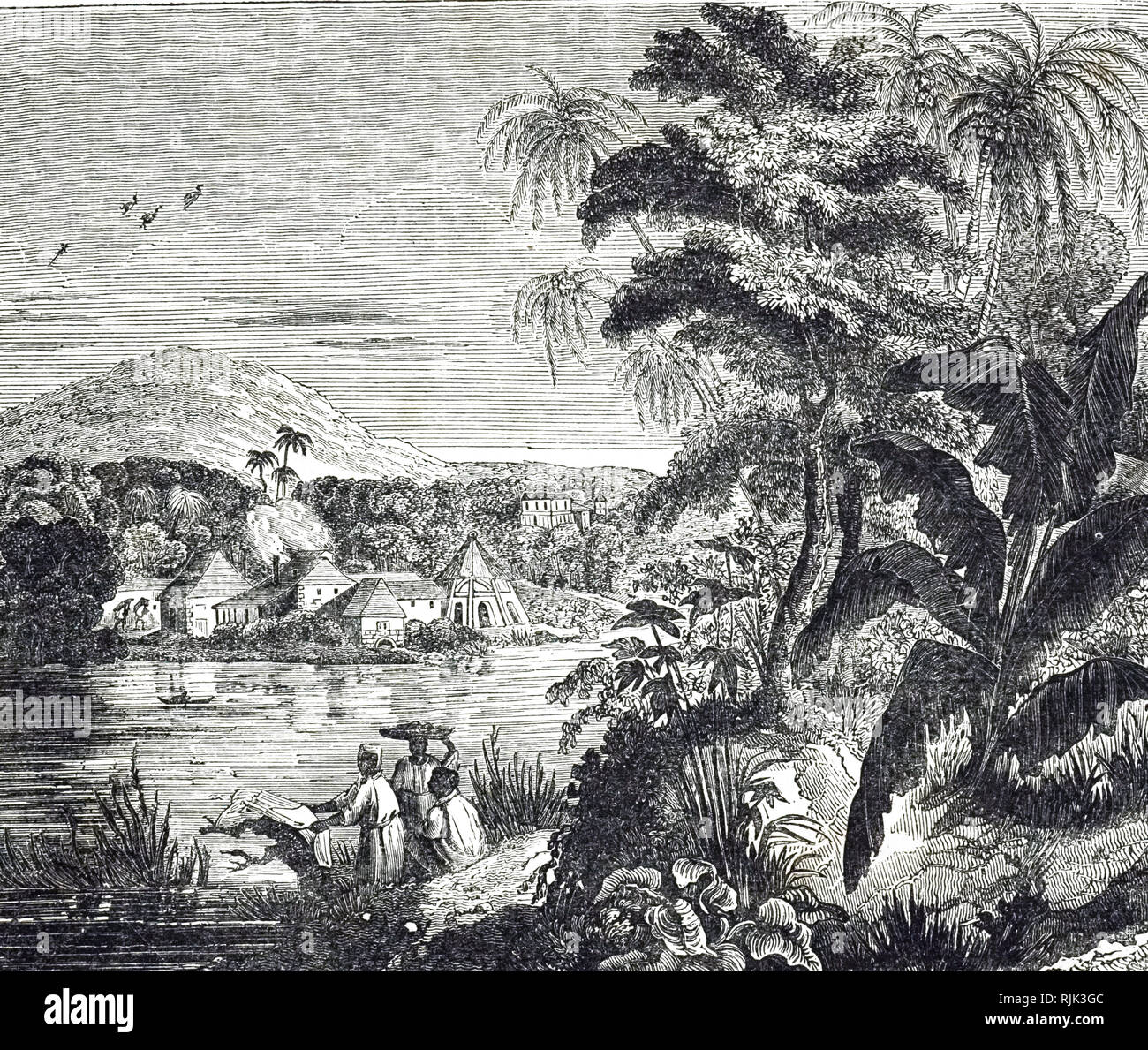 An engraving depicting a Jamaican sugarcane plantation during the sugar boom. African slaves harvested the sugar cane for their British owners. Dated 19th century Stock Photohttps://www.alamy.com/image-license-details/?v=1https://www.alamy.com/an-engraving-depicting-a-jamaican-sugarcane-plantation-during-the-sugar-boom-african-slaves-harvested-the-sugar-cane-for-their-british-owners-dated-19th-century-image235218492.html
An engraving depicting a Jamaican sugarcane plantation during the sugar boom. African slaves harvested the sugar cane for their British owners. Dated 19th century Stock Photohttps://www.alamy.com/image-license-details/?v=1https://www.alamy.com/an-engraving-depicting-a-jamaican-sugarcane-plantation-during-the-sugar-boom-african-slaves-harvested-the-sugar-cane-for-their-british-owners-dated-19th-century-image235218492.htmlRMRJK3GC–An engraving depicting a Jamaican sugarcane plantation during the sugar boom. African slaves harvested the sugar cane for their British owners. Dated 19th century
 Chained Slaves or Chain Gang Carrying Firewood Tanzania Africa. Vintage or Historic Engraving or Illustration 1864 Stock Photohttps://www.alamy.com/image-license-details/?v=1https://www.alamy.com/chained-slaves-or-chain-gang-carrying-firewood-tanzania-africa-vintage-or-historic-engraving-or-illustration-1864-image636016204.html
Chained Slaves or Chain Gang Carrying Firewood Tanzania Africa. Vintage or Historic Engraving or Illustration 1864 Stock Photohttps://www.alamy.com/image-license-details/?v=1https://www.alamy.com/chained-slaves-or-chain-gang-carrying-firewood-tanzania-africa-vintage-or-historic-engraving-or-illustration-1864-image636016204.htmlRM2YXN14C–Chained Slaves or Chain Gang Carrying Firewood Tanzania Africa. Vintage or Historic Engraving or Illustration 1864
 African slaves washing for diamonds at Mandanga on the River Jigitonhonha in Cerro de Frio, Brazil. From John Mawe's Travels in the Interior of Brazil, 1812. Copperplate engraving by Dall'Acqua handcoloured by Laxaretti from Giovanni Battista Sonzogno's Raccolta de Viaggi Piu Interessanti, Milan, 1815. Stock Photohttps://www.alamy.com/image-license-details/?v=1https://www.alamy.com/stock-image-african-slaves-washing-for-diamonds-at-mandanga-on-the-river-jigitonhonha-162811599.html
African slaves washing for diamonds at Mandanga on the River Jigitonhonha in Cerro de Frio, Brazil. From John Mawe's Travels in the Interior of Brazil, 1812. Copperplate engraving by Dall'Acqua handcoloured by Laxaretti from Giovanni Battista Sonzogno's Raccolta de Viaggi Piu Interessanti, Milan, 1815. Stock Photohttps://www.alamy.com/image-license-details/?v=1https://www.alamy.com/stock-image-african-slaves-washing-for-diamonds-at-mandanga-on-the-river-jigitonhonha-162811599.htmlRMKCTKRY–African slaves washing for diamonds at Mandanga on the River Jigitonhonha in Cerro de Frio, Brazil. From John Mawe's Travels in the Interior of Brazil, 1812. Copperplate engraving by Dall'Acqua handcoloured by Laxaretti from Giovanni Battista Sonzogno's Raccolta de Viaggi Piu Interessanti, Milan, 1815.
 Print shows several buildings along street engulfed in flames during fire on September 19, 1776, citizens being beaten by Redcoats, and looting by African slaves. Includes brief text (five lines) in both German and French that list some of the institutions destroyed by the fire. Stock Photohttps://www.alamy.com/image-license-details/?v=1https://www.alamy.com/print-shows-several-buildings-along-street-engulfed-in-flames-during-fire-on-september-19-1776-citizens-being-beaten-by-redcoats-and-looting-by-african-slaves-includes-brief-text-five-lines-in-both-german-and-french-that-list-some-of-the-institutions-destroyed-by-the-fire-image239644142.html
Print shows several buildings along street engulfed in flames during fire on September 19, 1776, citizens being beaten by Redcoats, and looting by African slaves. Includes brief text (five lines) in both German and French that list some of the institutions destroyed by the fire. Stock Photohttps://www.alamy.com/image-license-details/?v=1https://www.alamy.com/print-shows-several-buildings-along-street-engulfed-in-flames-during-fire-on-september-19-1776-citizens-being-beaten-by-redcoats-and-looting-by-african-slaves-includes-brief-text-five-lines-in-both-german-and-french-that-list-some-of-the-institutions-destroyed-by-the-fire-image239644142.htmlRMRWTMFA–Print shows several buildings along street engulfed in flames during fire on September 19, 1776, citizens being beaten by Redcoats, and looting by African slaves. Includes brief text (five lines) in both German and French that list some of the institutions destroyed by the fire.
 Arab traders throwing African slaves overboard to avoid capture by the British Navy 1800s. Hand-colored halftone of an illustration Stock Photohttps://www.alamy.com/image-license-details/?v=1https://www.alamy.com/stock-photo-arab-traders-throwing-african-slaves-overboard-to-avoid-capture-by-24125143.html
Arab traders throwing African slaves overboard to avoid capture by the British Navy 1800s. Hand-colored halftone of an illustration Stock Photohttps://www.alamy.com/image-license-details/?v=1https://www.alamy.com/stock-photo-arab-traders-throwing-african-slaves-overboard-to-avoid-capture-by-24125143.htmlRMBB6YT7–Arab traders throwing African slaves overboard to avoid capture by the British Navy 1800s. Hand-colored halftone of an illustration
 Colon, Panama. 18th Feb, 2015. A dancer in devil costume takes part in the Ash Wednesday celebration at Nombre de Dios village, Colon province, Panama, on Feb. 18, 2015. The dance of the 'Devil and Congo' represents the way in which African slaves and runaway salves mocking their masters during the colonial period, performing the good with the 'congos' and the evil with the devil figure, according to local press. © Mauricio Valenzuela/Xinhua/Alamy Live News Stock Photohttps://www.alamy.com/image-license-details/?v=1https://www.alamy.com/stock-photo-colon-panama-18th-feb-2015-a-dancer-in-devil-costume-takes-part-in-78851878.html
Colon, Panama. 18th Feb, 2015. A dancer in devil costume takes part in the Ash Wednesday celebration at Nombre de Dios village, Colon province, Panama, on Feb. 18, 2015. The dance of the 'Devil and Congo' represents the way in which African slaves and runaway salves mocking their masters during the colonial period, performing the good with the 'congos' and the evil with the devil figure, according to local press. © Mauricio Valenzuela/Xinhua/Alamy Live News Stock Photohttps://www.alamy.com/image-license-details/?v=1https://www.alamy.com/stock-photo-colon-panama-18th-feb-2015-a-dancer-in-devil-costume-takes-part-in-78851878.htmlRMEG80AE–Colon, Panama. 18th Feb, 2015. A dancer in devil costume takes part in the Ash Wednesday celebration at Nombre de Dios village, Colon province, Panama, on Feb. 18, 2015. The dance of the 'Devil and Congo' represents the way in which African slaves and runaway salves mocking their masters during the colonial period, performing the good with the 'congos' and the evil with the devil figure, according to local press. © Mauricio Valenzuela/Xinhua/Alamy Live News
 Jamaica sugar cane plant crop crops produced plantations Caribbean island mills mill farm farming sweet African slaves British Stock Photohttps://www.alamy.com/image-license-details/?v=1https://www.alamy.com/stock-photo-jamaica-sugar-cane-plant-crop-crops-produced-plantations-caribbean-39668970.html
Jamaica sugar cane plant crop crops produced plantations Caribbean island mills mill farm farming sweet African slaves British Stock Photohttps://www.alamy.com/image-license-details/?v=1https://www.alamy.com/stock-photo-jamaica-sugar-cane-plant-crop-crops-produced-plantations-caribbean-39668970.htmlRMC8F24X–Jamaica sugar cane plant crop crops produced plantations Caribbean island mills mill farm farming sweet African slaves British
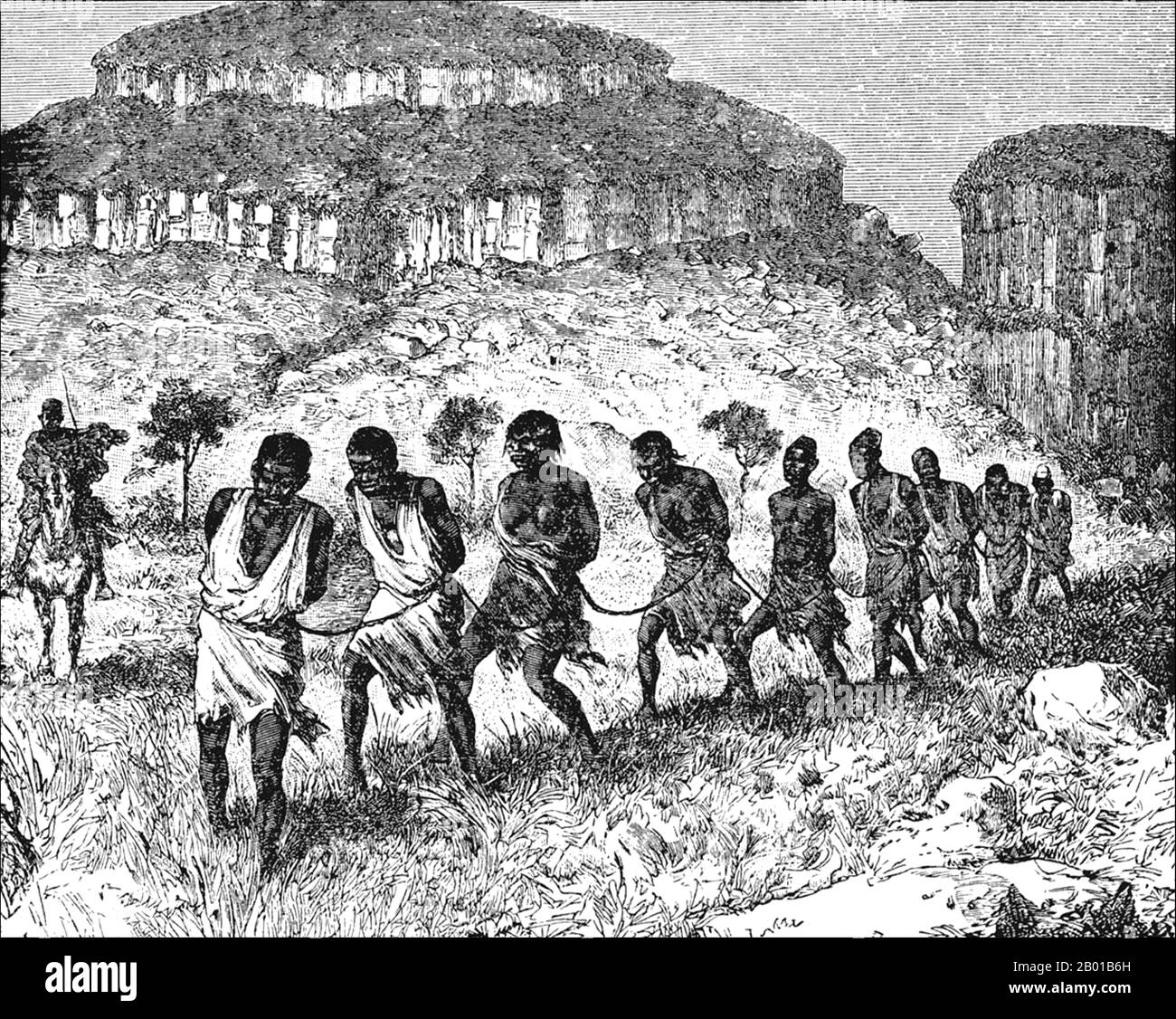 Senegambia/West Africa: 'The Mana-Oulè and Caravan of Slaves'. Illustration by Joseph Simon Gallieni (24 April 1849 - 27 May 1916), 1879. Black slaves were imported into the Muslim world from Africa by a number of routes northward across the Sahara desert, and by sea into Arabia and the Persian Gulf. Estimates of the number involved vary greatly but it seems that there may easily have been 10 million, perhaps even twice that number. Two-thirds of African slaves were female, as male slaves were considered to be troublesome. Stock Photohttps://www.alamy.com/image-license-details/?v=1https://www.alamy.com/senegambiawest-africa-the-mana-oul-and-caravan-of-slaves-illustration-by-joseph-simon-gallieni-24-april-1849-27-may-1916-1879-black-slaves-were-imported-into-the-muslim-world-from-africa-by-a-number-of-routes-northward-across-the-sahara-desert-and-by-sea-into-arabia-and-the-persian-gulf-estimates-of-the-number-involved-vary-greatly-but-it-seems-that-there-may-easily-have-been-10-million-perhaps-even-twice-that-number-two-thirds-of-african-slaves-were-female-as-male-slaves-were-considered-to-be-troublesome-image344238121.html
Senegambia/West Africa: 'The Mana-Oulè and Caravan of Slaves'. Illustration by Joseph Simon Gallieni (24 April 1849 - 27 May 1916), 1879. Black slaves were imported into the Muslim world from Africa by a number of routes northward across the Sahara desert, and by sea into Arabia and the Persian Gulf. Estimates of the number involved vary greatly but it seems that there may easily have been 10 million, perhaps even twice that number. Two-thirds of African slaves were female, as male slaves were considered to be troublesome. Stock Photohttps://www.alamy.com/image-license-details/?v=1https://www.alamy.com/senegambiawest-africa-the-mana-oul-and-caravan-of-slaves-illustration-by-joseph-simon-gallieni-24-april-1849-27-may-1916-1879-black-slaves-were-imported-into-the-muslim-world-from-africa-by-a-number-of-routes-northward-across-the-sahara-desert-and-by-sea-into-arabia-and-the-persian-gulf-estimates-of-the-number-involved-vary-greatly-but-it-seems-that-there-may-easily-have-been-10-million-perhaps-even-twice-that-number-two-thirds-of-african-slaves-were-female-as-male-slaves-were-considered-to-be-troublesome-image344238121.htmlRM2B01B6H–Senegambia/West Africa: 'The Mana-Oulè and Caravan of Slaves'. Illustration by Joseph Simon Gallieni (24 April 1849 - 27 May 1916), 1879. Black slaves were imported into the Muslim world from Africa by a number of routes northward across the Sahara desert, and by sea into Arabia and the Persian Gulf. Estimates of the number involved vary greatly but it seems that there may easily have been 10 million, perhaps even twice that number. Two-thirds of African slaves were female, as male slaves were considered to be troublesome.
 Vintage colour engraving circa 1821 of cotton making in the Dutch Antilles or Netherlands Antilles in the East Indies using African slaves. By the artist Paolo Fumagalli Stock Photohttps://www.alamy.com/image-license-details/?v=1https://www.alamy.com/vintage-colour-engraving-circa-1821-of-cotton-making-in-the-dutch-antilles-or-netherlands-antilles-in-the-east-indies-using-african-slaves-by-the-artist-paolo-fumagalli-image447602975.html
Vintage colour engraving circa 1821 of cotton making in the Dutch Antilles or Netherlands Antilles in the East Indies using African slaves. By the artist Paolo Fumagalli Stock Photohttps://www.alamy.com/image-license-details/?v=1https://www.alamy.com/vintage-colour-engraving-circa-1821-of-cotton-making-in-the-dutch-antilles-or-netherlands-antilles-in-the-east-indies-using-african-slaves-by-the-artist-paolo-fumagalli-image447602975.htmlRF2H0624F–Vintage colour engraving circa 1821 of cotton making in the Dutch Antilles or Netherlands Antilles in the East Indies using African slaves. By the artist Paolo Fumagalli
 A series of statistical charts illustrating the condition of the descendants of former African slaves now in residence in the United States of America Abstract: Map shows African American population distribution. Stock Photohttps://www.alamy.com/image-license-details/?v=1https://www.alamy.com/a-series-of-statistical-charts-illustrating-the-condition-of-the-descendants-of-former-african-slaves-now-in-residence-in-the-united-states-of-america-abstract-map-shows-african-american-population-distribution-image263753279.html
A series of statistical charts illustrating the condition of the descendants of former African slaves now in residence in the United States of America Abstract: Map shows African American population distribution. Stock Photohttps://www.alamy.com/image-license-details/?v=1https://www.alamy.com/a-series-of-statistical-charts-illustrating-the-condition-of-the-descendants-of-former-african-slaves-now-in-residence-in-the-united-states-of-america-abstract-map-shows-african-american-population-distribution-image263753279.htmlRMW92YYY–A series of statistical charts illustrating the condition of the descendants of former African slaves now in residence in the United States of America Abstract: Map shows African American population distribution.
 ROYAL AFRICAN COMPANY coat of arms Stock Photohttps://www.alamy.com/image-license-details/?v=1https://www.alamy.com/royal-african-company-coat-of-arms-image385052463.html
ROYAL AFRICAN COMPANY coat of arms Stock Photohttps://www.alamy.com/image-license-details/?v=1https://www.alamy.com/royal-african-company-coat-of-arms-image385052463.htmlRM2DACJ9K–ROYAL AFRICAN COMPANY coat of arms
 UNSIGNED CONTEMPORARY PAINTING SHOWING THE BLACK AFRICAN SLAVES CUTTING SUGAR CANE ON THE OLD PLANTATION IN LOS INGENIOS VALLEY, LISTED AS A WORLD HERITAGE SITE BY UNESCO, CUBA, THE CARIBBEAN Stock Photohttps://www.alamy.com/image-license-details/?v=1https://www.alamy.com/unsigned-contemporary-painting-showing-the-black-african-slaves-cutting-image64945744.html
UNSIGNED CONTEMPORARY PAINTING SHOWING THE BLACK AFRICAN SLAVES CUTTING SUGAR CANE ON THE OLD PLANTATION IN LOS INGENIOS VALLEY, LISTED AS A WORLD HERITAGE SITE BY UNESCO, CUBA, THE CARIBBEAN Stock Photohttps://www.alamy.com/image-license-details/?v=1https://www.alamy.com/unsigned-contemporary-painting-showing-the-black-african-slaves-cutting-image64945744.htmlRMDNJEXT–UNSIGNED CONTEMPORARY PAINTING SHOWING THE BLACK AFRICAN SLAVES CUTTING SUGAR CANE ON THE OLD PLANTATION IN LOS INGENIOS VALLEY, LISTED AS A WORLD HERITAGE SITE BY UNESCO, CUBA, THE CARIBBEAN
 88 A series of statistical charts illustrating the condition of the descendants of former African slaves now in residence in the United States of America LCCN2014645352 Stock Photohttps://www.alamy.com/image-license-details/?v=1https://www.alamy.com/88-a-series-of-statistical-charts-illustrating-the-condition-of-the-descendants-of-former-african-slaves-now-in-residence-in-the-united-states-of-america-lccn2014645352-image212753720.html
88 A series of statistical charts illustrating the condition of the descendants of former African slaves now in residence in the United States of America LCCN2014645352 Stock Photohttps://www.alamy.com/image-license-details/?v=1https://www.alamy.com/88-a-series-of-statistical-charts-illustrating-the-condition-of-the-descendants-of-former-african-slaves-now-in-residence-in-the-united-states-of-america-lccn2014645352-image212753720.htmlRMPA3NF4–88 A series of statistical charts illustrating the condition of the descendants of former African slaves now in residence in the United States of America LCCN2014645352
 Painet iy8063 child kid brazil girl tinbo quilombo pernambuco quilombos first settled descendants african slaves escaped 300 Stock Photohttps://www.alamy.com/image-license-details/?v=1https://www.alamy.com/stock-photo-painet-iy8063-child-kid-brazil-girl-tinbo-quilombo-pernambuco-quilombos-11211229.html
Painet iy8063 child kid brazil girl tinbo quilombo pernambuco quilombos first settled descendants african slaves escaped 300 Stock Photohttps://www.alamy.com/image-license-details/?v=1https://www.alamy.com/stock-photo-painet-iy8063-child-kid-brazil-girl-tinbo-quilombo-pernambuco-quilombos-11211229.htmlRFA569BX–Painet iy8063 child kid brazil girl tinbo quilombo pernambuco quilombos first settled descendants african slaves escaped 300
 A bracelet made by West African slaves from Italian beads circa 1750-1820 is shown at the History Museum of Mobile, March 19, 2019, in Mobile, Alabama. Stock Photohttps://www.alamy.com/image-license-details/?v=1https://www.alamy.com/a-bracelet-made-by-west-african-slaves-from-italian-beads-circa-1750-1820-is-shown-at-the-history-museum-of-mobile-march-19-2019-in-mobile-alabama-image241465121.html
A bracelet made by West African slaves from Italian beads circa 1750-1820 is shown at the History Museum of Mobile, March 19, 2019, in Mobile, Alabama. Stock Photohttps://www.alamy.com/image-license-details/?v=1https://www.alamy.com/a-bracelet-made-by-west-african-slaves-from-italian-beads-circa-1750-1820-is-shown-at-the-history-museum-of-mobile-march-19-2019-in-mobile-alabama-image241465121.htmlRMT0RK69–A bracelet made by West African slaves from Italian beads circa 1750-1820 is shown at the History Museum of Mobile, March 19, 2019, in Mobile, Alabama.
 The Emperor of Morocco, under the sunshade, riding to his castle which was built by English slaves. The African Adventure - A History of Africa's Explorers by Timothy Severin, page 62. Stock Photohttps://www.alamy.com/image-license-details/?v=1https://www.alamy.com/the-emperor-of-morocco-under-the-sunshade-riding-to-his-castle-which-was-built-by-english-slaves-the-african-adventure-a-history-of-africas-explorers-by-timothy-severin-page-62-image268794231.html
The Emperor of Morocco, under the sunshade, riding to his castle which was built by English slaves. The African Adventure - A History of Africa's Explorers by Timothy Severin, page 62. Stock Photohttps://www.alamy.com/image-license-details/?v=1https://www.alamy.com/the-emperor-of-morocco-under-the-sunshade-riding-to-his-castle-which-was-built-by-english-slaves-the-african-adventure-a-history-of-africas-explorers-by-timothy-severin-page-62-image268794231.htmlRMWH8HNY–The Emperor of Morocco, under the sunshade, riding to his castle which was built by English slaves. The African Adventure - A History of Africa's Explorers by Timothy Severin, page 62.
 Pedro Alvares Cabral discovering Brazil 34, African slaves washing washing diamonds 35, and the Portuguese royal family arriving in Brazil in 1807 36. Handcoloured copperplate engraving from Rev. Isaac Taylors Scenes in America, for the Amusement and Instruction of Little Tarry-at-Home Travelers, John Harris, London, 1821. Stock Photohttps://www.alamy.com/image-license-details/?v=1https://www.alamy.com/pedro-alvares-cabral-discovering-brazil-34-african-slaves-washing-washing-diamonds-35-and-the-portuguese-royal-family-arriving-in-brazil-in-1807-36-handcoloured-copperplate-engraving-from-rev-isaac-taylors-scenes-in-america-for-the-amusement-and-instruction-of-little-tarry-at-home-travelers-john-harris-london-1821-image571823887.html
Pedro Alvares Cabral discovering Brazil 34, African slaves washing washing diamonds 35, and the Portuguese royal family arriving in Brazil in 1807 36. Handcoloured copperplate engraving from Rev. Isaac Taylors Scenes in America, for the Amusement and Instruction of Little Tarry-at-Home Travelers, John Harris, London, 1821. Stock Photohttps://www.alamy.com/image-license-details/?v=1https://www.alamy.com/pedro-alvares-cabral-discovering-brazil-34-african-slaves-washing-washing-diamonds-35-and-the-portuguese-royal-family-arriving-in-brazil-in-1807-36-handcoloured-copperplate-engraving-from-rev-isaac-taylors-scenes-in-america-for-the-amusement-and-instruction-of-little-tarry-at-home-travelers-john-harris-london-1821-image571823887.htmlRM2T68R5K–Pedro Alvares Cabral discovering Brazil 34, African slaves washing washing diamonds 35, and the Portuguese royal family arriving in Brazil in 1807 36. Handcoloured copperplate engraving from Rev. Isaac Taylors Scenes in America, for the Amusement and Instruction of Little Tarry-at-Home Travelers, John Harris, London, 1821.
 Indigo Bottle Tree Beaufort South Carolina USA Stock Photohttps://www.alamy.com/image-license-details/?v=1https://www.alamy.com/indigo-bottle-tree-beaufort-south-carolina-usa-image1205436.html
Indigo Bottle Tree Beaufort South Carolina USA Stock Photohttps://www.alamy.com/image-license-details/?v=1https://www.alamy.com/indigo-bottle-tree-beaufort-south-carolina-usa-image1205436.htmlRMAJ64BD–Indigo Bottle Tree Beaufort South Carolina USA
 A series of statistical charts illustrating the condition of the descendants of former African slaves now in residence in the United States of America LCCN2014645360 Stock Photohttps://www.alamy.com/image-license-details/?v=1https://www.alamy.com/stock-image-a-series-of-statistical-charts-illustrating-the-condition-of-the-descendants-162738825.html
A series of statistical charts illustrating the condition of the descendants of former African slaves now in residence in the United States of America LCCN2014645360 Stock Photohttps://www.alamy.com/image-license-details/?v=1https://www.alamy.com/stock-image-a-series-of-statistical-charts-illustrating-the-condition-of-the-descendants-162738825.htmlRMKCNB0W–A series of statistical charts illustrating the condition of the descendants of former African slaves now in residence in the United States of America LCCN2014645360
 Slaves cutting the sugar cane in Antigua. Y William Clark 1827 Stock Photohttps://www.alamy.com/image-license-details/?v=1https://www.alamy.com/slaves-cutting-the-sugar-cane-in-antigua-y-william-clark-1827-image634302149.html
Slaves cutting the sugar cane in Antigua. Y William Clark 1827 Stock Photohttps://www.alamy.com/image-license-details/?v=1https://www.alamy.com/slaves-cutting-the-sugar-cane-in-antigua-y-william-clark-1827-image634302149.htmlRM2YRXXT5–Slaves cutting the sugar cane in Antigua. Y William Clark 1827
 Zanzibar Slave Women Being Released from Slavery Tanzania. Vintage or Old Illustration or Engraving 1889 Stock Photohttps://www.alamy.com/image-license-details/?v=1https://www.alamy.com/zanzibar-slave-women-being-released-from-slavery-tanzania-vintage-or-old-illustration-or-engraving-1889-image353613162.html
Zanzibar Slave Women Being Released from Slavery Tanzania. Vintage or Old Illustration or Engraving 1889 Stock Photohttps://www.alamy.com/image-license-details/?v=1https://www.alamy.com/zanzibar-slave-women-being-released-from-slavery-tanzania-vintage-or-old-illustration-or-engraving-1889-image353613162.htmlRM2BF8D5E–Zanzibar Slave Women Being Released from Slavery Tanzania. Vintage or Old Illustration or Engraving 1889
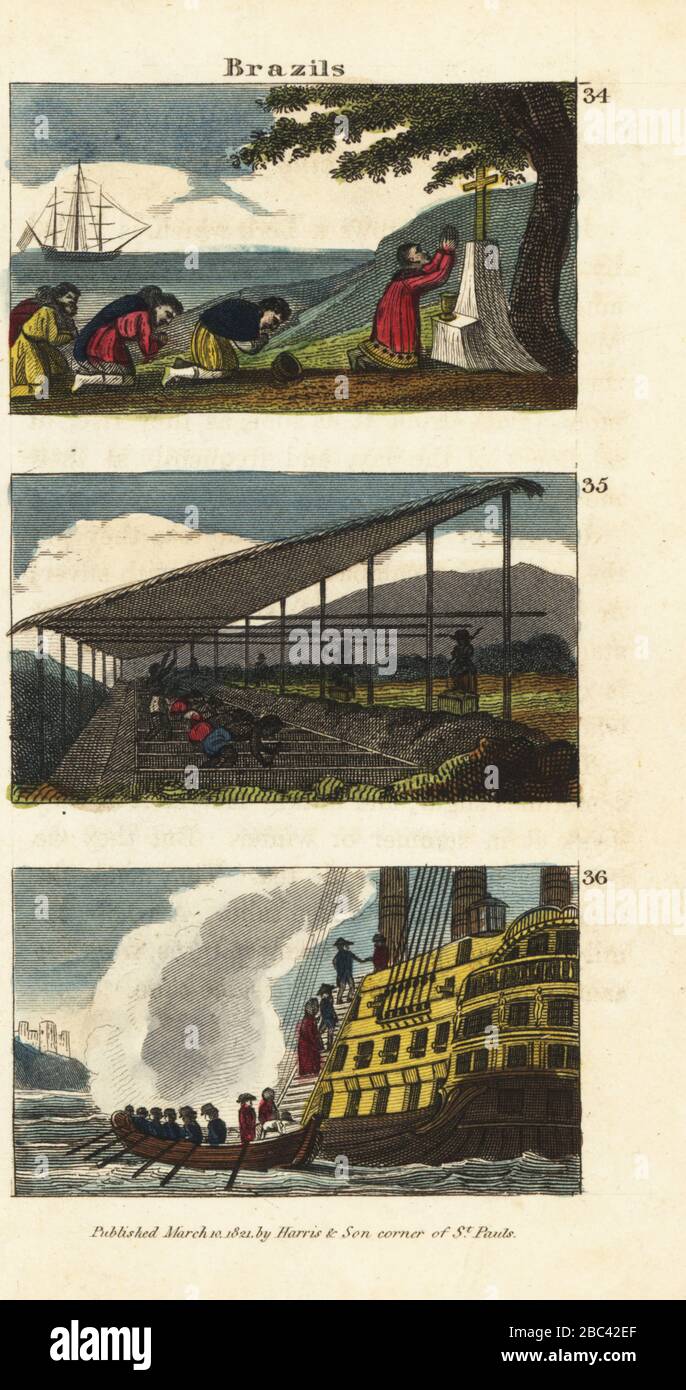 Pedro Alvares Cabral discovering Brazil 34, African slaves washing washing diamonds 35, and the Portuguese royal family arriving in Brazil in 1807 36. Handcoloured copperplate engraving from Rev. Isaac Taylor’s Scenes in America, for the Amusement and Instruction of Little Tarry-at-Home Travelers, John Harris, London, 1821. Stock Photohttps://www.alamy.com/image-license-details/?v=1https://www.alamy.com/pedro-alvares-cabral-discovering-brazil-34-african-slaves-washing-washing-diamonds-35-and-the-portuguese-royal-family-arriving-in-brazil-in-1807-36-handcoloured-copperplate-engraving-from-rev-isaac-taylors-scenes-in-america-for-the-amusement-and-instruction-of-little-tarry-at-home-travelers-john-harris-london-1821-image351673015.html
Pedro Alvares Cabral discovering Brazil 34, African slaves washing washing diamonds 35, and the Portuguese royal family arriving in Brazil in 1807 36. Handcoloured copperplate engraving from Rev. Isaac Taylor’s Scenes in America, for the Amusement and Instruction of Little Tarry-at-Home Travelers, John Harris, London, 1821. Stock Photohttps://www.alamy.com/image-license-details/?v=1https://www.alamy.com/pedro-alvares-cabral-discovering-brazil-34-african-slaves-washing-washing-diamonds-35-and-the-portuguese-royal-family-arriving-in-brazil-in-1807-36-handcoloured-copperplate-engraving-from-rev-isaac-taylors-scenes-in-america-for-the-amusement-and-instruction-of-little-tarry-at-home-travelers-john-harris-london-1821-image351673015.htmlRM2BC42EF–Pedro Alvares Cabral discovering Brazil 34, African slaves washing washing diamonds 35, and the Portuguese royal family arriving in Brazil in 1807 36. Handcoloured copperplate engraving from Rev. Isaac Taylor’s Scenes in America, for the Amusement and Instruction of Little Tarry-at-Home Travelers, John Harris, London, 1821.